

Qowat Milat
- View history

Sisters of the Qowat Milat say goodbye to Jean-Luc Picard
The Qowat Milat , formally the Order of the Qowat Milat , were a group of Romulan warrior nuns . They were an all- female group; while a male could train in their ways, he could never truly be one of them. The Qowat Milat were the most feared enemies of the Tal Shiar , and, by extension, the Zhat Vash . ( PIC : " Absolute Candor "; DIS : " Choose to Live ")
- 1 Beliefs and practices
- 3.1 Affiliates
- 4 External link
Beliefs and practices [ ]
The primary teaching of the Qowat Milat was the Way of Absolute Candor , i.e. the total communication of emotion without filter between thought and word; this ran counter to everything that mainstream Romulans held dear. According to Zani , theirs was a "house of truth". Another of their sayings was " a promise is a prison ."
Jean-Luc Picard described the Qowat Milat as " the most skilled single-combat fighters that I have ever seen ". Indeed, they were sometimes mistaken for assassins . They wielded swords known as tan qalanq . When possible, before attacking they offered their opponents a chance to retreat with the phrase, " Please, (my) friend(s), choose to live. " This was an abbreviation of a longer saying: "The path you are on has come to an end. Choose to live." It meant that the person could opt to move onto a new path in their life and live, or stay on their present course and die. ( PIC : " Absolute Candor "; DIS : " Choose to Live ")
The Qowat Milat could not be hired, though their assistance could be requested. A Qowat Milat sister could choose to bind her sword to a singular cause as a qalankhkai , or "freeblade", if she judged the cause worthy. The criterion for worthiness was that the cause be a lost one. This criterion also extended to providing their services as shalankhkai during the T'Kal-in-ket . ( PIC : " Absolute Candor ", " The Impossible Box ", " Nepenthe "; DIS : " Unification III ")
A traditional Qowat Milat gesture of greeting, goodbye, or acknowledgment was to press their palms together, then spread them outward like opening a book. ( PIC : " Absolute Candor ")
History [ ]
In the early 2380s , the Qowat Milat provided invaluable assistance to Admiral Jean-Luc Picard during the Federation effort to rescue Romulans from the impending Romulan supernova . On Vashti alone, they helped to relocate over 250,000 refugees . At this time, they took in an orphan boy, Elnor . Although this was meant to be a temporary arrangement, he would grow up among them. After the Attack on Mars in 2385 led to the withdrawal of Federation support, Qowat Milat qalankhkan contributed to maintaining the peace on Vashti.
In 2399 , Picard traveled to Vashti aboard La Sirena to beg the Qowat Milat's help for his quest to find and protect Soji Asha . At the urging of their leader Zani, Picard made his case to Elnor, who agreed to bind himself to the mission as a qalankhkai . ( PIC : " Absolute Candor ")
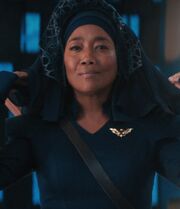
Gabrielle Burnham in 32nd century Qowat Milat robes
The Qowat Milat played an essential role in establishing trust between the Vulcans and Romulans in the early days following the reunification of their societies. They continued to facilitate healthy discourse between the two peoples through the Burn into the 32nd century . Only sisters of the Qowat Milat were permitted to act as shalankhkai for the process of T'Kal-in-ket . ( DIS : " Unification III ")
In 3189 , Gabrielle Burnham acted in that role for her daughter Michael Burnham . ( DIS : " Unification III ")
In 3190 , Dr. Burnham, along with her daughter, Lieutenant Sylvia Tilly , and another sister of the order undertook a joint Federation-Ni'Var mission to apprehend J'Vini . ( DIS : " Choose to Live ")
Members [ ]
- Gabrielle Burnham
Affiliates [ ]
External link [ ].
- Qowat Milat at Memory Beta , the wiki for licensed Star Trek works
- 3 Ancient humanoid
Star Trek: Who Are The Qowat Milat?
Meet the warrior nuns known as the Qowat Milat, the guardians of honor in the Star Trek universe.
Countless civilizations and cultures coexist in Star Trek , each with its own unique ideologies and traditions. Among these is the Qowat Milat, a fascinating group known for their unwavering commitment and the pursuit of lost causes. This obscure but captivating sisterhood plays a significant role in the life of one of Starfleet's most revered captains, Jean-Luc Picard.
These resilient warrior nuns, born of Romulan origin, bring a compelling layer of complexity to the galaxy envisioned by Gene Roddenberry . With their commitment to absolute truth and their connection to a legendary Starfleet captain, the Qowat Milat have carved out a unique niche in the lore of this beloved franchise. Here's what fans should know about them.
RELATED: Star Trek Fans Should Check Out Gene Roddenberry's Other Sci-Fi Series
Origin and History of The Qowat Milat
The Qowat Mila are known for their unwavering devotion to the concept of the "Absolute Candor." This principle dictates that they speak only the truth, unfiltered and unvarnished, even when it is painful or inconvenient for them or those around them. Their origins trace back to the turmoil of the Romulan Empire, a society marked by secrecy and deception. In response to this environment, the Qowat Milat emerged as a beacon of honesty, striving to counterbalance the deception that pervaded their world.
This order, first introduced in the television series Picard , consists exclusively of Romulan women who have chosen to dedicate their lives to this path. They have forsaken familial and personal connections to become the protectors of truth, seeking to rectify the falsehoods and duplicity that plagued their society. While they are not affiliated with the official government or military, their influence is far-reaching, and their principles resonate deeply with the values upheld by Starfleet.
The Qowat Milat played an indispensable role in cultivating trust between the Vulcans and Romulans in the early stages following the reunification of their societies. Their commitment to facilitating constructive dialogue endured through the Burn and into the 32nd century.
Jean-Luc Picard Connection
The Qowat Milat's connection to the Star Trek universe is most prominently shown in the relationship between Captain Jean-Luc Picard and Elnor, a young Romulan warrior raised by the Qowat Milat. Introduced in Picard , Elnor's story is closely entwined with Picard's quest to protect and relocate Romulan refugees following the catastrophic supernova of their star. After a chance encounter, Elnor becomes a devoted protector of Picard, embodying the principles of the Qowat Milat.
Jean-Luc Picard marvels at the formidable prowess of the Qowat Milat, hailing them as "the most skilled single-combat fighters that I have ever seen." Often, their unparalleled combat abilities led some to misconstrue them as covert agents. Armed with distinctive tan qalanq swords, they adhered to a unique tradition of offering adversaries a chance to withdraw gracefully, prefacing their confrontations with the plea, "Please, (my) friend(s), choose to live."
The bond between Picard and Elnor showcases the Qowat Milat's code of Absolute Candor in action. Elnor's unwavering commitment to truth, even when it means challenging his revered mentor, underscores the depth of the Qowat Milat's principles . Through their interactions, viewers get a glimpse into the transformative power of this Romulan order and its potential to inspire change in the broader Star Trek universe.
Notable Members
Gabrielle Burnham, introduced in Star Trek: Discovery , is a member of the Qowat Milat despite not being Romulan. She is the mother of Michael Burnham , the series' protagonist. Gabrielle's journey from being a scientist working on time-travel experiments to becoming a member of the Qowat Milat is a testament to the order's profound impact. Her commitment to the pursuit of truth eventually leads her to embrace the principles of the Qowat Milat, reinforcing the idea that the quest for Absolute Candor can transcend the boundaries of time and space.
J'Vini is another influential member of the Qowat Milat, whose story unfolds in the pages of Star Trek novels. Her character delves into the intricate web of Romulan politics and espionage, showing how the Qowat Milat navigate treacherous waters while adhering to their principles. J'Vini exemplifies the order's role in uncovering and confronting the hidden truths that shape the destiny of civilizations in the Star Trek universe.
In Picard , two Qowat Milat members named Shai and Zani join Elnor in his quest to protect Picard and uphold their commitment to Absolute Candor. These two warrior nuns exhibit remarkable combat skills and unshakable loyalty to their principles. Their presence adds depth and authenticity to the portrayal of the Qowat Milat , emphasizing their dedication to justice and their role in safeguarding the truth.
The Qowat Milat are a captivating addition to the intricate tapestry of cultures in the Star Trek universe. Their devotion to Absolute Candor and noble causes, as well as their impact on characters like Jean-Luc Picard and Elnor, demonstrate the enduring power of their philosophy. While the sisterhood remains shrouded in mystery , their commitment to truth and justice continues to inspire and resonate throughout the cosmos. They serve to remind viewers of the power of unwavering principles in the face of adversity.
MORE: Star Trek: Disruptors, Explained
Waiting for Picard: Elnor Actor Evan Evagora on Being Abandoned by Jean-Luc
Talking to the romulan boy who became a warrior..
Kabar and O’Toole: The Audition
Star trek: picard photos.

Elnor, the Qowat Milat, and an Absent Picard

IGN Recommends

Star Trek: Picard episode 4 recap: A fan favorite character joins Picard's crew
Our spoiler-filled Star Trek: Picard episode 4 review

- Episode 4 (of 10), ' Absolute Candor' - Written by Michael Chabon - Directed by Jonathan Frakes ★★★★
Spoilers follow .
On a desert planet called Vashti, Picard visits some of the Romulan refugees he's been helping to resettle. This was 14 years ago, when he was still an admiral with Starfleet. He meets with Zani, the leader of a group known as the Qowat Milat – Romulan warrior nuns and, as we learn later, enemies of the Tal Shiar. They're looking after a boy, Elnor, whom Picard seems to have a fondness for. He reads to him from The Three Musketeers and they enjoy a spot of play-fencing. Then Picard receives a call from Raffi: synths have attacked Mars.
Back in the present day, Picard explores a holodeck recreation of his vineyard on the La Sirena. Raffi is furious to discover that Picard has asked Rios to take a detour to Vashti. The planet is very different now, she says, ruled by warlords and protected by an impenetrable web of killer drones. Raffi softens when she realises that losing Dahj has made Picard think about his relationship with Elnor.
On the Borg cube, Soji watches a holo-recording of Ramdha talking about Ganmadan, the Day of Annihilation. She and other Romulans believe that "shackled demons" will one day break their chains and "answer the call of the Destroyer", which Soji has been referred to as several times—including once to her face by Ramdha.
- How to watch Star Trek: Picard online
- Star Trek: Discovery season 3 : release date predictions and what we know
- Our Star Trek Picard episode 3 recap
Troubled by this discovery, Soji meets with Narek and asks him what happened to Ramdha's ship, the Shaenor. He says that information is classified, stored on the Borg cube's computers, but that he might know someone who can access it. Soji also reveals to Narek that she knows he's spying on her. In turn, he says there are details about her past that don't add up. But before they can delve any deeper into their respective secrets, they goof around in an air vent together, sliding up and down it in their bare feet. Narek seems to be falling for Soji.
Picard beams down to Vashti and instead of the hero's welcome he got in the flashback, he's met with sneers and suspicious looks. A sign on a cafe reading ROMULANS ONLY is another clue that things have taken a turn for the worse here. He receives a warmer welcome from Zani, who is pleased to see him. She asks Picard to take Elnor, now a Qalankhkan, a mercenary, on his mission with him. She says he's grown into a formidable fighter. Elnor initially refuses, saying Picard abandoned him. But when Picard is almost killed by some angry Romulans, Elnor steps in and saves him, and agrees to "bind his blade" with him.

Back on the cube, Zhat Vash agent Rizzo is once again hassling Narek about his lack of progress in his mission. The goal, she says, is to kill "them all", and to find out where "the others" are. This is our first clue that there may be other Maddox-brand organic synths out there, not just Dahj and Soji. Narek is told he has one more week left.
Get daily insight, inspiration and deals in your inbox
Get the hottest deals available in your inbox plus news, reviews, opinion, analysis and more from the TechRadar team.
Above Vashti, the La Sirena flees from a pursuing Romulan Bird of Prey, flown by a local warlord called Kar Kantar. Things are looking hopeless, but an unknown ship flies in and gives them a window to escape. Just before this mystery craft is destroyed by the Romulans, the pilot is beamed aboard the La Sirena and is revealed to be none other than Star Trek : Voyager's former Borg, Seven of Nine.
Verdict: This is the most Picard has felt like classic Star Trek, which may be a result of it being directed by series veteran Jonathan Frakes. We're no closer to Bruce Maddox, but this detour is worth it for the addition of both Seven of Nine and Elnor to the crew. Elnor is the star of the show here, being essentially a sci-fi Legolas from Lord of the Rings, and I can't wait to see more of him in future episodes.
- You can learn more about Picard's new allies, the Qowat Milat, in spin-off novel The Last Best Hope, written by Una McCormack. This group of warrior nuns believes in absolute truth, which makes them natural enemies of the shady, secretive Tal Shiar.
- This is the first episode of Picard directed by Jonathan Frakes, who played William Riker in The Next Generation. Frakes has a long history of directing Star Trek, including episodes of TNG, Voyager, Deep Space Nine, and Discovery. He also directed the movies First Contact and Insurrection, and PC game Star Trek: Klingon.
- Elnor briefly mentions Spot, Data's cat. According to the TNG short story anthology The Sky's the Limit, Worf took ownership of her following Data's death. After helping Worf sniff out an alien infestation on the Enterprise, he came to respect her as a warrior.
Star Trek: Picard is available to watch on CBS All Access every Thursday in the US, and every Friday on Amazon Prime Video internationally.
- How to watch Star Trek in order
- What we know about Star Trek: Picard season 2
Netflix’s The Gentlemen season 2 thrown into doubt due to ‘challenges getting the same actors back’
'I cried': Arcane star claims season 2 of the hit Netflix show will emotionally devastate fans
Integral Crypto Dual FIPS 140-2 Encrypted USB 3.0 review
Most Popular
By Sead Fadilpašić April 09, 2024
By Timothy Coleman April 09, 2024
By Demi Williams April 09, 2024
By Mike Moore April 09, 2024
By Tom Power April 09, 2024
By Carrie Marshall April 09, 2024
By Craig Hale April 09, 2024
By Chiara Castro April 09, 2024
- 2 Ninja Woodfire Pro Connect XL BBQ Grill and Smoker review
- 3 IKEA's affordable new smart LED wall panel is an impressively versatile mood light
- 4 Programmers got PSP games running on the PlayStation Portal, then “responsibly reported” the exploit so it could be patched
- 5 Quordle today – hints and answers for Monday, April 8 (game #805)
- 2 Siri is truly terrible, but I'm optimistic about its rumored iOS 18 reboot – here's why
- 3 Google has a new way to try and stop cookie theft leading to possible cyberattacks
- 4 Leaked iPhone 16 dummy units show design changes for all four phones
- 5 Sonic vs rotating toothbrushes: Which is better?

- April 10, 2024 | ‘Star Trek: Discovery’ Season 5 Preview Offers Intriguing Clues And The Return To [SPOILERS]
- April 10, 2024 | Mary Wiseman Really Doesn’t Want To Talk About Tilly Returning On ‘Star Trek: Starfleet Academy’
- April 9, 2024 | Sonequa Martin-Green Talks About Exhausting Last Day On Set For ‘Star Trek: Discovery’
- April 9, 2024 | Review: The EXO-6 ‘Star Trek: Deep Space Nine’ 1:6 Odo Figure Is The Shape of Things To Come
- April 9, 2024 | ‘Star Trek: Discovery’ Director Fesses Up To Unplanned Cameo In Episode 502
Michael Chabon Reveals His ‘Star Trek: Picard’ Romulan Mythology… In Intimate Detail
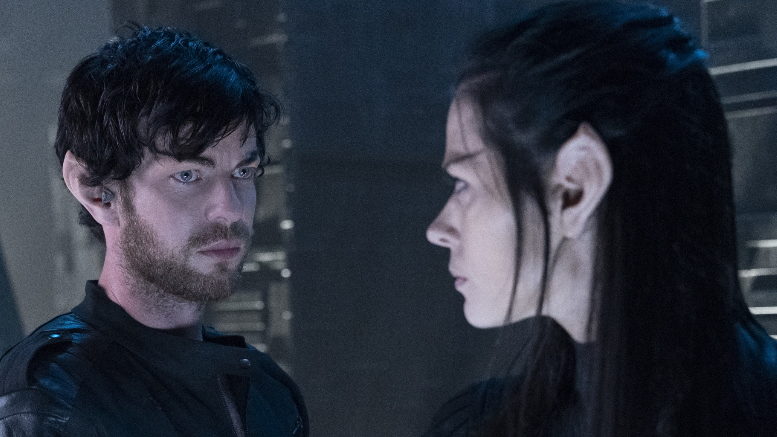
| March 8, 2021 | By: TrekMovie.com Staff 67 comments so far
As showrunner for the first season of Star Trek: Picard , Michael Chabon developed some intricate backstories for various storylines. A lot of what he developed never ended up on screen, but it helped inform the writers and production team as well as contribute to the worldbuilding. Recently, the Pulitzer Prize-winning author has taken to sharing some of these backstories online. We’ve seen this previously with how he filled in the story of Riker and Troi and their family life on the USS Titan , and now his latest release goes into depth on the Romulans.
Chabon’s Romulan thesis
Romulans were a major part of the first season of Star Trek: Picard . Even though they were introduced in the first season of Star Trek: The Original Series and have been featured throughout the franchise since, they’ve remained enigmatic and haven’t had the same level of fleshing out that some other familiar Star Trek races have like Vulcans and Klingons. In Chabon’s latest post on Medium titled “ Some Notes On Romulans ,” he lays out more about Romulan society, making that enigmatic nature a central element, starting off with this:
Their culture is an endless series of variations on themes of concealment, the covert, the hidden: masks, pseudonyms, conspiracies, layers of deception, cover stories.
The rest of the excellent post reads like everything you always wanted to know about Romulans but were afraid to ask. He covers how their secretive philosophy impacts everything from architecture to art to religion to government and more.
In one example, he shows how Romulan tendencies impacted the development of their most iconic technology and their preferred ship nomenclature:
Legend holds that the basis of Romulans’ fixation on deception and the hiding of secrets is the unusually high proportion of mimetic (camouflage-using) native animals and plants that the first settlers of Romulus found on arrival, snakes that look like flowering vines, flowers like lizards, mammals that alter their coloration according to patterns in light falling on them. Best known of these to outsiders, of course, is the so-called “warbird” after which Romulans have long patterned their military starships. The plumage of this raptor has unique optical properties that mimic the wavelength of ambient light, causing the birds to “disappear” against a clear blue sky, a phenomenon that is said to have inspired the most celebrated, and most Romulan, of all Romulan technologies: the cloaking device.
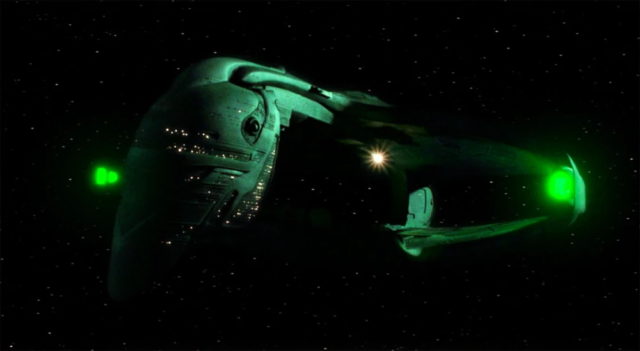
D’deridex class warbird
One of the new elements of Romulan society that Chabon introduced in Picard was the order of Qowat Milat warrior nuns who believe in “absolute candor,” which he describes as a “radical inversion of mainstream Romulan belief.” Even though they hold a completely different point of view, the writer revealed they still hold some sway at the highest levels of Romulan society:
It is whispered, however, that no one becomes Romulan praetor without the approval of the Qowat Milat, and furthermore that the Romulan Empress is always drawn from, or trained by, the Qowat Milat sisters. Fierce, brash, forthright, they wear their hearts on their sleeves, hold nothing back, and always call a spade a spade. In short, there could be no stronger ally than a Qowat Milat sister: unless, of course, your mission actually requires you to engage in subterfuge and deception.
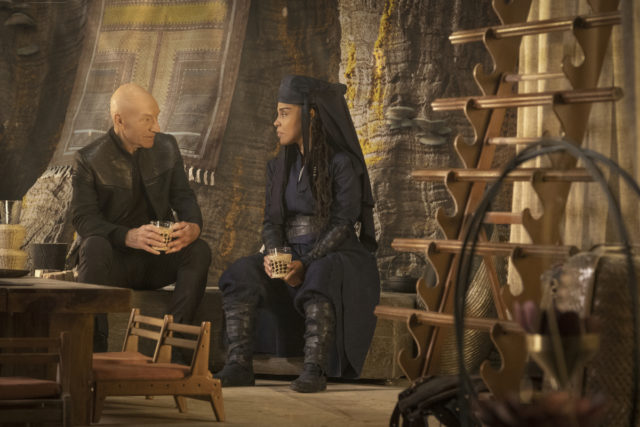
Jean-Luc Picard with Qowat Milat sister Zani (Amirah Vann) in “Absolute Candor”
Romulan marriage is… complicated
Chabon lays out how the Romulan obsession with secrecy includes each individual having four names, with one being their “innermost name,” revealed only to a trusted few. Among those trusted few would be those involved in a marriage, which he reveals is complex:
Romulan “marriages” (the word translates as “trust bond”) are always threesomes (in any configuration of genders) because at every moment each partner in the marriage serves as Verificator to the other two (in Romulan the verb “to verify” is related to verbs meaning. “to police” and “to monitor”), verifying the trust bond of the two others, who are known by a Romulan word that literally translates as “conspirators.” In practice the threesome may or may not cohabit/reproduce — there is great variability here.
According to Chabon, Romulan society has “flexibility and liberty in many social matters, such as sexual orientation, gender fluidity” and there is no concept of adultery , as Romulans can have other sexual partners outside their “trust bond.”
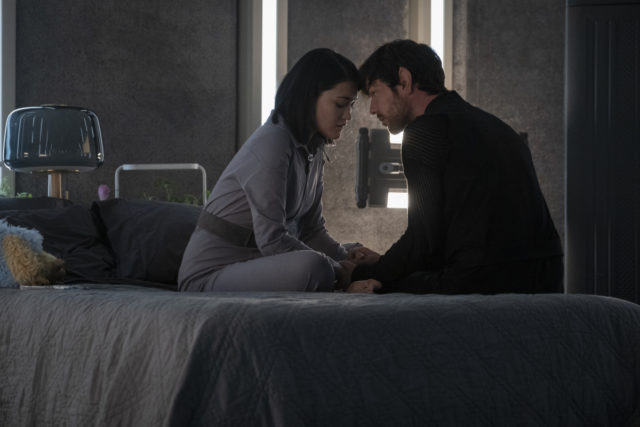
Isa Briones as Dahj and Harry Treadaway as Narek
While much of what Chabon lays out was not seen on screen, it is likely influencing other elements of Picard and beyond. We saw the Qowat Milat again in season three of Star Trek: Discovery for example. And many aspects of Romulan secrecy worked their way into James Swallow’s recent novel Star Trek: Picard – The Dark Veil , which also drew on Chabon’s backstory for the Rikers.

Check out “ Some Notes On Romulans ” for even more details from Michael Chabon.
See more Star Trek: Picard news and analysis at TrekMovie.com .
Related Articles

Collectibles , Star Trek: Picard , TOS
Star Trek Coffees Launching In May With Several Blends
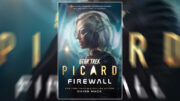
Books , Review , Star Trek: Picard , VOY
Review: Action-Packed ‘Star Trek: Picard: Firewall’ Reveals Seven’s Compelling Quest For Identity

All Access Star Trek Podcast , Discovery , Lower Decks , Star Trek: Picard , Star Trek: Prodigy , Starfleet Academy , Strange New Worlds
Podcast: All Access Goes To SXSW For The ‘Star Trek: Discovery’ Season 5 Premiere

Star Trek: Picard

‘Picard’ Season 2 Was Rewritten After Paramount Deemed It “Too Star Trek,” Says EP
That’s super cool. Greatly enjoyed the more varied side of the Romulans in Picard, it was in fact one of my favorite elements. It contributed well to worldbuilding for me. Hope Chabon stays with Star Trek Picard beyond the second season!
His leaving as showrunner is not a good sign, unfortunately. I thoroughly enjoyed Picard (yes, including the finale) and think his writing had a good deal to do with that.
He’s leaving the show because CBS gave him another show.
He did however stay in the writers room for Picard season two while working on developing his novel for television.
So, we can expect at least an episode or two penned by Chabon.
Matalas is a high quality writer too. There’s dialogue in 12 monkeys that really stays with one.
That’s good to know.
This aspect of “picard” was…poorly excecuted.
Really? I think the updating of the Romulans was awesome. It made things richer and more interesting and found a way to thread the needle with the many many different Romulan looks we’ve seen throughout the years.
No, in fact, they nailed it!
Why do you place Picard’s name in quotes?
I’m guessing it’s to distinguish the show from the character.
I disagree. The romulan aspect was the best thing about Picard. I’ve always felt the Romulans were the true enemy of TNG and not the Borg.(we got both in Picard, I’m not complaining)
They also served quite well as a surprise explanation on why the vulcans in ENTERPRISE acted so a-holelike or aholy.
I’d like to see Chabon do a coffee table book on the origins of Romulus, Q’onos, Vulcan and other alien worlds in Star Trek.
MAKE IT SO!
So is that why Picard has two Romulans in his house? Are they in a relationship?
And is that why there’s no Beverly around?
The “3rd” could have died on Romulus.
Or Picard is the 3rd.
It was implied that the two were in a relationship, but there was no indication they were married.
I believe – half-humorously, half-salaciously – these revelations mean Picard was in a threesome.
If the filmed story ever makes this relationship explicit – even if it was not a sexual one as indicated by Chabon’s notes – Picard’s eventual reunion with Beverly will be even more interesting.
Within Season One, Picard must have understood Narek was a bit deeper and insightful than he appeared. Did Picard operate on the Romulan’s level of secrecy? Or Has Picard has become so aware of the Romulan’s culture that he believes he can’t trust most of them? Why was Starfleet soooo stupid not to make Picard’s insights into Romulan culture a part of their intelligence team?
Maybe an aside, maybe not: since Picard believes he will “never return home again.” This means his legacy – his vineyard – is left to the Romulan couple.
Okay… but why are the Romulan siblings seemingly incestuous? (Or at least very flirtatious.)
My guess is they could be related by marriage only, and not actual blood relatives. Possibly step brother/step sister.
They probably watched one too many bootleg holotapes of Game of Thrones.
Actually Akiva Goldsmith said somewhere he originally wanted them to be having sex and even see them together basically as a couple. But others shot it down (thank god) but he still fought for them to at least imply they COULD be having sex and that’s why it’s there. So no, it’s not anyone reading too much into something, they literally were suppose to be incestuous with each other, just not say it outright basically. How this guy got to be so involved in Star Trek I will never know? He has come up with some of the dumbest ideas with these shows.
He’s running SNW… I’m really worried. I’m still remaining positive but I have serious doubts.
He’s buddies with Kurtzman. I don’t know how these charlatans have embedded themselves so deeply into Star Trek, but it’s nothing short of a tragedy.
This is one of the most comically overdramatic things I’ve ever read.
You must be new around here and haven’t seen many other of my comments on here! X
That’s hot.
OK, so he wanted them to have an incestuous bond. Fine with me. Akiva, just one question please:
What that has to do with the story as told? All the bad guys in Picard season 1 are so 2 dimensional, that you have to wonder whether the story/script didn’t start as something completely different and it ended you this way after numerous rewrites that laundered the whole thing became nonsensical in parts. You don’t have to get your villains to twirl a mustache, to make sure the viewers get that they’re the villains. Especially since in the end they kinda turn out to be in the right 100%. The coming of monster-AI as revealed by the Admonition was a genuine concern for life in our galaxy, so the Tal Shiar within Tal Shiar (let me get to that in a second) was IN THE RIGHT to act. Just consider – Discovery crew acted on the same threat and they come up as the good guys. I know there’s a difference in methods, but – Romulans be Romulans.
Overall, as for the whole Chabon fancition – I’m sorry, but the fun is in the secret. The most compelling races are of course those with rich backstory, but, c’mon – this is Romulans, who are SECRETIVE. That’s their allure. In TNG and DS9 it was a point that we (Starfleet) had to forcefully drag shreds of information about their peoples, customs, technology, politics, etc. out of the darkness, often at a cost. In Picard and this Chabon write-up we’re spoon-fed with details via regular, run-of-the-mill exposition. Revealing things about Romulans this way is informative, but not fun.
Imagine what it’d be like if we weren’t promptly informed about Narek’s intentions in no less, than episode 2! What it’d be like if we were kept in the dark, like Soji, until episode 6 when he tries to kill her and only then we’d learn he’s working with his sister. Wouldn’t that work better? I realize this comes with some problems, because you pretty much don’t need the sister anymore in the story, as she does nothing but harass Narek for the first 4 episodes, and then she’s venting the ex-B’s only to be offed by 7 of 9. She’s so paper thin that she’s almost a non-character, story-wise.
He was also the guy who was acting like a giddy teenager when talking about klingons having two members. In fact wasn’t he the guy who was responsible for that whole two-membered klingon debacle?
Because the show runners watched too much Game of Thrones.
Yah, it seemed to be the shiny new titillating thing Akiva wanted to put in for no necessary plot reason. (I recall he also is responsible for the Klingon peeing against the wall in Discovery’s S1 finale.)
And yet he seems to have been the one that Chabon relied on to keep them on track to land the key plot point of the season’s conclusion (i e. Picard’s choice to become a synth to model good synth choices). Chabon’s talked about how Goldsman was the one telling him to “remember the object” of the series.
Again this seems to be a case of not having anyone able or willing to coral the big egos and keep things coherent.
I’m hopeful that Terry Matalas will have insisted on locking down the plot of the final two seasons of Picard the way he did 12 monkeys. Certainly with Covid, he’s had the opportunity to reshape the scripts since he became showrunner in the Spring of 2020. Coherence is his strength and that is the thing Picard most lacked.
Goldsman and SNW will be interesting. It’s episodic so if there is weird and trippy titillation, it won’t be a constant.
There is a second showrunner listed so there may be a balancing voice, but Goldsman will surely get what he wants unless it crosses a line for Anson Mount.
Er, that link doesn’t actually take us to Chabon’s post “Some Notes on Romulans”; it only takes us to the previous TrekMovie article about Chabon’s thinking about the Rikers.
Umm… the “Some notes on Romulans” hyperlink keeps taking me to the page on Riker and Troi on the Titan…
Insert *it’s a fake* meme.
Wow, I really dig the inspiration for the cloaking device and warbird.
Yes, I do, too!
The link isn’t working, but the link to Chabon’s blog is circulating on Twitter. Mixed bag. Some aspects are interesting, but the thing that most catches my attention is there doesn’t seem to be way the QM as presented in the notes could exist while the Tal Shiar do. (At least not in a technologically advanced setting; I could see them fitting in very well in a tradition similar to Japanese warrior-monk monasteries, where dislodging them would mean nothing short of going to war with a small military state.) I guess they could be a cultural holdover allowed to exist because of their traditional link to the ruling class, but that’s kind of a letdown.
It’s all fine, but don’t love it so much that I’d agitate to have Chabon take the lead again. Mostly I wish more effort had gone into the three Romulans we saw most of. If the Lannister twins had been combined into one character concept, we might have had one, interested well-rounded protagonist for the season.
Antagonist. Geez, brain.
It’s interesting stuff, but it shows that he doesn’t know the Romulans well, in my opinion. Some of that is contradicted by past episodes, especially the bit about marriages always being threesomes.
Nah, it’s easily explained in that we just didn’t see the third partner in past eps, and also that the Romulans didn’t want to publicize this practice with outside cultures. They’ve always been very private about their personal lives. So plenty of room for canon creativity here.
which episodes contradict it? I don’t recall seeing many or any Romulan marriages or relationships explored onscreen in Star Trek.
The bit about Romulan marriages is interesting, but I wonder how consistent it is with what we know of Vulcanoid biology. The Romulan “hijra” from Vulcan did not take place that long ago — a few thousand years, at absolute most, and probably more like 2,500. That’s not enough time for significant evolution to occur in a species (even if you buy Stephen J. Gould’s theory about evolution occurring in spurts). So Romulans have to have at least some vestige of pon farr, even if they control it pharmacologically or have found a way to mitigate it with Vulcanoid telepathy. We’ve never seen Vulcans pairing up in threes.
Moreover, the flirting scenes between Spock and the Romulan commander in “The Enterprise Incident” showed courtship rituals that were very similar to what we saw between Vulcan couples in “Amok Time” and “Journey to Babel.” So again, query how consistent the threesome idea is with Vulcanoid biology, which Romulans definitely share to some degree.
And that telepathy is a question also; can Romulans mind meld, or even do the neck pinch? TNG “Gambit” suggested that the Romulan government was indeed interested in telepathic experiments.
“a few thousand years, at absolute most, and probably more like 2,500.”
Yet in the U.S, in twenty years we’ve gone from a largely homophobic country to legalizing gay marriage, plus acceptance of trangenders, etc. And then we have the Mormons who went from polygamy to monogamy in less than a century.
So 2500 years is easily no big deal for that practice to become a standard.
Neither homophobia nor polygamy are regulated by biological processes like Pon Farr, so I don’t think these are good examples. Perhaps going from omnivore to vegetarianism would be a better one.
Those are social changes, not biological ones. And indeed “Amok Time” suggests that pon farr is various much impervious to social changes; it is more powerful than modern Vulcan’s commitment to logic.
Just speaking for myself, but getting a second wife to call mine and my first wife’s bullsh** seems inefficient. That’s what couples therapists are for. And their loyalty is assured by fees and licensure. Aaand they can see 35-40 couples a week. Romulans if nothing else should be appreciative of efficiency.
It’s fascinating, but Chabon joins John Logan, Kurtzman and Robert Orci as yet another high profile writer who took a shine to the Romulans and planned great things for them, only to see a fraction of that promise achieved onscreen. Compare how the Romulans have been fleshed out since Nemesis to the Klingons post-The Search for Spock, the Borg, the Bajorans, the Cardassians or the Dominion. It’s pretty woeful IMO, and knowing all this love was put into their backstory just makes that more frustrating to me.
I’ve sometimes wondered if the Romulans would’ve been a better choice in Voyager than the Maquis as the “other” crew in the series. Certainly it would’ve provided more drama and given them an opportunity to flesh out Romulan culture by being forced to live with them. But on the other hand, I do like Chakotay, Torres and Paris in the show as it was. Just a thought anyway.
Absolutely. Frankly, the Maquis were not that interesting outside of the Cardassian DMZ. I don’t think it’s a coincidence that some of the less successful VOY characters were Maquis.
Yeah I just don’t get it either. The Romulans has always been one of the most fascinating species in Star Trek and yet they were always shown to be very one dimensional in pretty much everything, especially TNG IMO. I didn’t have an issue with how they were portrayed on the show, only that they were ONLY portrayed in one way most of the time. It was the same in TOS obviously but I cut them some slack because they were basically in two episodes and I thought they were set up great at least, even if they were basically there to be the bad guys; but lots of potential obviously. DS9 we at least saw them working with the Federation for the first time in the Dominion war (admittedly through some very manipulated means ;)) but they basically played the boogeyman for most of the franchise and little else.
And then what’s odder is that they were cut off at the knees twice in the films as they were supposed to be in both TSFS and Insurrection. They finally gave them their big moment in Nemesis but made it about the Remans…ugh. They’re the worst! ;)
So I was happy to see them on Picard and FINALLY given some real development just like the Cardassians, Bajorans, Borg, Klingons and others got over and over again. It was literally why I was happy they kept the Hobus star explosion canon because we literally got to go in Romulan territory in a real way and explore it. For the most part it was good IMO, but yeah they still dropped the ball in others. I liked the stuff with the Qowat Millet group or the ex-Tal Shar characters living with Picard. That was thinking outside of the box.
But then we still got the same one dimensional Romulans yet again with the incest siblings and Romulans secretly up to no good. There was a lot of potential there for sure, probably the most we ever seen them develop but it still went back to the same stuff we seen over and over again. We’re right back to the Romulans are evil and you can never ever trust them. Maybe we will see more of them in season 2. I wouldn’t mind that at all, but I’m not holding my breath to be anything different.
Also why I loved that they finally reunited them with the Vulcans on Discovery. Now we have the potential to see a really different side of them and got a taste of that in Unification III (and why going forward is great because you CAN do stuff like this).
For sure. Picard is the deepest we’ve delved into their society since Unification or Face of the Enemy, with Unification III having some nice tantalizing threads they could pull on further. But for all their screen time since TNG, we’ve learned surprisingly little compared to what we gleaned through Worf, Ro, Kira, Garak, Dukat, Odo and Seven. Trek never investing in a Romulan recurring character made them very surface. They started as a stand-in for Cold War China, then were mostly just surface villains. We learned so little about their culture, religion, socio-politics, history… some of that was by design, but after being the villains in two movies, it is striking how much Michael Chabon was able to retcon – they are almost a blank canvas. And then again, frustrating how little of that materialized onscreen. Lots of promise with the Qowat Milat and Picard’s friends at the chateau, but the follow-through was tepid IMO. The scenes on the cube with the siblings were like the scenes on Romulus in Nemesis – stopped everything dead.
Also that Romulan liaison officer in the DS9 “The Search.”
Had she stayed on, it might have been interesting. Would certainly have created tension a la Ro or Seven. I have no idea if that was the plan or if Martha Hackett was given a choice between her and Seska.
Agreed. On screen the warrior nun “please choose to live” stuff felt like a misfired Orientalist fantasy. Watching the cafe scene you just had no idea how Trek got like this.
I also don’t like the idea of turning the Romulans into a Decepticon-like people whose whole culture is based on trickery. It’s not a very IDIC way of envisioning an alien people.
Give me the soulfulness of John Ford’s Final Reflection canon for Klingons.
I am very critical of “PULITZER-AWARD WINNING” Michael Chabon – it’s really important you’re reminded of this every day. He won a Pulitzer, you know? Do not dare to question his ability as a Star Trek writer!!!
Whilst I think Star Trek Picard was nothing short of an… ummm… unmitigated disaster and do think Chabon has to own some of that, the above extracts do show some promise and vindicate him… slightly. There are some decent ideas there.
I just want to know if the Brother and Sister made out.
I know that Star Trek Online is fairly niche, even among Star Trek fans, but IMO they did a great job expanding on Romulan/Reman culture far better than anything Picard or Discovery has given us of a post-Nemesis galaxy.
STO’s Romulan material has been largely in place since at least 2013, with a portion dating back to late-2010. After the Hobus supernova destroys Romulus, The Romulan Star Empire shatters into sects, allowing for the birth of the (largely peaceful) Romulan Republic. I feel like is one of the few hopeful things that has come out of any post-Nemesis Trek media.
I fully understand that writers/producers have no interest in dipping into STO lore, but I wanted to point out that it’s out there and was pretty well developed already. Hundreds of thousands (or if you believe what you read online, millions) of fans over the years have been exposed to that lore, it would have been interesting to see that lore expanded on instead of a parallel development being built up from scratch, especially if a bunch of it will never see the light of day anyway.
I’m all for this. Chabon is expanding the Romulans in a similar way to how Ron Moore expanded on the Klingons. Or how Ira Behr expanded on the Ferengi. I say let him go at it.
Immaculate. Chabon’s one of the best gets in modern Trek. I hope he remains in the writers room for Picard’s likely third season.
One of the best aspects of Picard is the expansion of the Romulan culture.
Since I first watch TOS back in the 60’s when it came out on TV, I was intrigued by the Romulans more than the Klingons. Not that I did not enjoy the TOS Klingons, Kor is my favorite of all time, Perhaps it has to do with he was the first I saw, or that he appeared twice more (later in his life) on DS9 or that he was part of the Star Trek slot machine that came out in 2008 in that Klingon on ship battle bonus with his quotes from “Errand of Mercy”. Romulans always seemed to get passed over after “Balance of Terror”. Its good to flesh out the Romulans more. We shall see where it all goes in S2 of PICARD.
Chabon is unstable imo. Too much trust given for Picard. Hence season 1
Four names? Hm…is Chabon a secret T.S.Eliot/Cats fan? Makes me think immediately of the poem “The naming of cats” by T.S.Eliot “ I tell you a cat must have three different names…”, check it out for some levity :D
- The Original Series
- The Animated Series
- The Next Generation
- Deep Space Nine
- Strange New Worlds
- Lower Decks
- Star Trek Movies
- TrekCore on Twitter
- TrekCore on Facebook

Follow TV Tropes
http://tvtropes.org/pmwiki/pmwiki.php/Recap/StarTrekPicardS1E04AbsoluteCandor
Recap / Star Trek: Picard S1E04 "Absolute Candor"
Edit locked.

As per usual for this show, The Teaser is a Flashback . It's the evacuation of the Romulan Star System— which the Federation clearly halted partway through, as Picard is visiting refugees on the planet Vashti and discussing the ongoing efforts with them. He is the guest of the Qowat Milat, a Romulan sect of warrior nuns, and he spends quality time with a boy named Elnor, a Heartwarming Orphan whom the sisters adopted despite his gender. Picard and Elnor are bonding over The Three Musketeers when the admiral gets paged about the First Contact Day Synth Attacks, and he leaves abruptly to (try to) do something about it.
Picard is in the holodeck, where the Emergency Hospitality Hologram has re-created his study at Chateau Picard. His solitude is interrupted by everyone on the ship: Raffi charges in and demands to know why "Go to Freecloud" suddenly turned into "Have a Side Quest on Vashti," Rios hates the fucking EHH, and Dr. Jurati is just bored. Raffi directly questions Picard's state of mind, while Rios brings up more practical concerns: the Qiris sector, formerly a part of the Romulan Neutral Zone, has become a Wretched Hive , with only Vigilante Militia organizations like the Fenris Rangers providing any sort of order; Vashti in particular is now under the "protection" of the warlord Kar Kantar, who rules the sector with a 23rd-century Romulan Bird-of-Prey (see TOS : " Balance of Terror "). Besides, Vashti is rife with the " Romulan Rebirth " movement. But Picard is convinced that the services of a Qowat Milat warrior nun is his best shot; besides, he knows that he is unlikely to have a chance to pass this way again, and Dahj's death has him thinking of Elnor. If the Qowat Milat don't want to help, they'll say so: they practice the Way of Absolute Candor (aka Brutal Honesty ).
On the Artifact, Soji is watching an old TiVo recording of a Romulan talk show while she plays with pixmit cards. In the projection, Ramdha is talking about "Ganmadan," which the Romulans say is the Day of Annihilation . She says how the day is the end of all life everywhere, when shackled demons will answer the call of Seb-Cheneb, the Destroyer.
Picard beams down to the surface of Vashti. In the flashback, the Romulans were eager to meet him; now, fourteen years later, they show little besides veiled hostility. (The "Romulans Only" sign at the Romulan Social Club doesn't help.) He visits the nunnery of the Qowat Milat to beg them for help. Elnor, now grown up, treats him with nothing but contempt, remembering only the Parental Abandonment that Picard showed him. However, Zani, the head of the warrior nuns, urges Picard to make his case to Elnor. He can never join the Qowat Milat on account of being male, but he is trained in their ways; Zani also wants him (Elnor) to see some of the galaxy instead of being stuck on Vashti.
Soji syncs up with Narek about Ramdha, who attempted suicide after her meeting with Soji. She has noticed that Narek has no (visible) rank or badges of authority, and wonders whether he might be Tal Shiar. To distract her, Narek takes her to a corner of the Borg Cube, in Environmental Control, which has become a makeshift Sock Slide Rink . However, their fun (and smooching) is interrupted when Narek asks about how she came to the Artifact. According to her own reports, she was aboard the USS Ellison , but the ship's passenger manifest shows no record of her ever being there. It's hard to tell whether Soji is more disturbed by the allegations that she's hiding something, or the idea that she doesn't know her own past.
From orbit, Raffi picks up signs that Romulans are passing the news of Picard's arrival. Picard is ready to head shipside, but the security systems around the planet (installed by the aforementioned Fenris Rangers) only allow beaming every half-hour. So Picard tries once again to make friends with the local Romulans... by tearing down the "Romulans Only" sign. He is then approached by an ex-Romulan Senator named Tenqem Adrev, clearly a member of the Romulan Rebirth movement, who accuses Picard and Starfleet of trying to undermine Romulan independence. Picard protests the accusations, but Adrev isn't really interested in a debate; he's interested in a Sword Fight . Picard refuses . Adrev also isn't interested in a fair fight, but Picard doesn't get skewered; instead, Elnor appears, drawing his own blade. "Please, my friend. Choose to live." When Adrev and his companions don't, Elnor swiftly beheads Adrev. ("I regret your choice.") He then declares that he has, in fact, chosen to take up Picard's cause in the Qowat Milat fashion, and declares himself Picard's qalankhkai. Picard then addresses the crowd in general and Elnor in particular, apologizing for failing his (former) Romulan friends.
Aboard La Sirena , Picard has stern words with Elnor: the young man must swear to serve Picard, to hurt who he wants hurt, but also to refrain from killing anyone else. Elnor agrees. Agnes asks how Picard managed to gain the allegiance of a Qowat Milat, and Picard explains that he merely fit the requirements: a qalankhkai will only swear themselves to a lost cause .
There's another conversation between Narissa and Narek about the latter's (lack of) progress with Soji. The only new bit of information dropped is that the two believe that Soji is not the Last of Her Kind : there are more, and the Zhat Vash want all of them dead. Since Narek buttering Soji up is really the only way that they can get the location of the other synths, he's allowed to proceed.
Kar Kantar's ship has arrived. La Sirena begins its evasive maneuvers, but they are trapped between the old Bird-of-Prey (which, despite being 150 years older, is still larger and more powerful) and the defensive satellites in orbit around Vashti. The turning point comes when a smaller ship plunges in and attacks; now faced with two more nimble ships, the Bird-of-Prey is overpowered. However, it manages to land a critical hit on the new ship. As the crippled vessel tumbles towards the planetary shields, its pilot hails La Sirena (Picard orders a channel opened; Rios agrees) and requests to be beamed aboard (Picard orders it done; Rios agrees).
"You owe me a ship, Picard," Seven of Nine declares, before passing out on the floor.
This episode won an Emmy Award for Outstanding Prosthetic Makeup for a Series, Limited Series, Movie or Special.
- Absurdly Sharp Blade : Elnor's tan qalanq (a sword used by the Qowat Milat) can slice a person's head off with a single stroke, and it's a very Clean Cut .
- Accidental Misnaming : Mister Hospitality pronounces Zhaban as "Chee-ban."
- Rios demonstrates his top-notch starship piloting skills during his David Versus Goliath battle with Kar Kantar.
- Before they meet, Rios praises Seven of Nine as a magnificent pilot to his Emergency Tactical Hologram while she helps him fight off Kar Kantar.
- Alien Arts Are Appreciated : The Romulan orphan Elnor is delighted when Admiral Picard brings him a copy of The Three Musketeers and teaches him how to fence.
- Alien Blood : After Elnor beheads Tenqem, green blood oozes out of the latter's neck just before his head falls off.
- Alien Sky : In the wide shot of North Station on Vashti, there are two suns in the sky.
- Alliterative Name : Ka r Ka ntar, the Romulan warlord who attacks La Sirena near the end of the episode.
- All of the Other Reindeer : Elnor feels out of place among his fellow Romulans, who contemptuously label him as a "sisterboy" because he grew up among nuns. Even within the Qowat Milat monastery that he calls home, his gender sets him apart because the order only accepts women. Picard : It can't be easy being the only boy in a house of women. [Elnor] must get lonely sometimes. Zani : Yes. He is loved, but he does not belong with us.
- Amazon Brigade : The Qowat Milat is a very ancient order of Romulan warrior nuns who are so exceptionally skilled in combat that even the Tal Shiar fears them.
- The Apprentice : Elnor learned hand-to-hand combat skills from the Qowat Milat nuns. Zani informs Picard that Elnor had completed his training last spring, but he cannot join their order because he's a man.
- Arboreal Abode : The Qowat Milat sisterhood lives inside a solitary, gigantic tree which towers above all the others within the forest next to North Station; it's an idyllic setting for a monastery. The rooms, which are fully-furnished, have been carved into the tree trunk and they're quite spacious, but there are no doors or windows, just curtains which separate one area from another. (The planet Vashti has two suns , so it never gets cold there, and the nuns are such badass warriors that they don't worry about intruders.)
- Archaic Weapon for an Advanced Age : Several Romulans at North Station carry a sword. The main weapon of the Qowat Milan is a tan qalanq, an Absurdly Sharp Blade .
- Elnor gives a stern warning to the crowd right after he decapitates Tenqem, who was about to kill Picard (English translation of the original Romulan): "I have bound myself to Picard as qalankhkai. Anyone who threatens him will be choosing to die."
- Shortly afterwards, Elnor conveys his supreme confidence in his martial arts skills: "Fight a Qowat Milat and the outcome is not in doubt."
- Big Damn Heroes : Elnor and his tan qalanq arrive just in time to rescue Picard from Tenqem. The thug loses his head when he ignores Elnor's warning to back down.
- Bilingual Bonus : In Farsi, qowat milat means "power of the people," which is an apt name for a sect of Romulan warrior nuns who defy the Tal Shiar .
- Binary Suns : The planet Vashti is located in a binary star system, and both suns shine down on North Station.
- Bond One-Liner : After beheading Tenqem, Elnor follows up with: Elnor: I regret your choice.
- Boring, but Practical : Raffi describes Vashti's planetary defense system as primitive, but effective.
- Break Out the Museum Piece : The Qiris sector warlord Kar Kantar has a TOS -era Romulan Bird-of-Prey. It's not particularly dangerous on its own, as Rios notes that it has an outdated targeting system and is less maneuverable than La Sirena . However, fighting it is complicated by their needing to avoid Vashti's planetary defense system at the same time, and the Bird-of-Prey is fast enough that they can't simply warp away without disabling it.
- Broken Pedestal : The opening flashback shows that Picard used to be revered by the Romulans on Vashti. Fourteen years later, that reverence has faded to resentment.
- Brutal Honesty : The Qowat Milat believe in "absolute candor," a total display of emotion and truth when speaking to others, which is completely the opposite of Romulan society in general (and kind of foreign to their Vulcan forebears as well, who tend to prefer controlled displays of the same). Zani, the leader of the Qowat Milat, demonstrates this with her blunt response to the boy Elnor about why Picard doesn't like children. Zani : Because they're demanding, distracting, and interfere with duty and pleasure alike. (Picard gestures that he agrees with Zani) Young Elnor : My feelings are hurt.
- Bullying a Dragon : Picard knows that the locals are armed and none-too-fond of him, but he nevertheless deliberately rips off a "Romulans Only" sign and steps on it to make his displeasure of the current divisions known.
- Calling the Old Man Out : Elnor is bitterly disappointed that he's only seeing Picard, whom he regards as a surrogate father, for the first time in fourteen years because Picard needs something from him, and lets him know this in no uncertain terms. Picard : Will you come with me? Will you bind your sword to my quest? Elnor : (angrily) Now that you have use for me? Now that I have value to you? You left me on my own, old man. Picard : I never meant to— Elnor : I see no reason not to do the same. (leaves in a huff)
- Cannot Spit It Out : This leads to an Ironic Episode Title . Picard, building on his long-standing character traits from TNG , is unable to confess his guilt to Elnor or his true motives for wanting him to come. Instead, he simply tells him that he needs a good fighter, which, while true, is far from the whole story. This nearly causes Elnor to refuse to join him, but he ultimately reconsiders.
- Changed My Mind, Kid : Elnor initially refuses to join Picard out of bitterness towards his father figure for leaving him fourteen years ago, but Elnor changes his mind just as Picard picks a fight with the locals, who threaten to kill him.
- Chekhov's Classroom : Rios and Raffi brief Picard and Jurati on the geopolitical developments in the Qiris sector that they're about to visit, including mentioning a petty Romulan warlord named Kar Kantar who is terrorizing the region with an antique Romulan Bird-of-Prey. Sure enough, before the episode is up, Kantar's Bird-of-Prey shows up to attack the protagonists. The same conversation also mentions the Fenris Rangers , one of whom (Seven of Nine) comes to help La Sirena fight off Kantar.
- Chekhov's Skill : Picard teaches boy Elnor how to sword-fight, showing that he has the skill when Tenqem challenges him— he simply refuses to use it.
- Soji lampshades that the records on the Borg databases are classified.
- Narek informs Soji that Romulan passenger lists are kept private, unlike Terran ones.
- Color Wash : The Qowat Milat monastery scenes have a strong orange tint, although it's slightly less intense for North Station.
- Continuity Nod : Soji does a very android-like head twitch during her conversation with Narek, much like Data used to.
- Conveniently an Orphan : No normal Romulan would ever want to be part of Picard's motley crew, but Elnor has undergone unique circumstances which would eventually lead him to accept Picard's offer to join him on a rescue mission. He's an orphaned refugee who is being cared for by the Qowat Milat sisterhood, whose members are friends and allies of Picard, so this creates the opportunity for the young Elnor to bond with his idol as a surrogate son since the Admiral (who happens to be childless) is the only positive male role model in his life. Although Picard would abandon Elnor for fourteen years, and the young man is very resentful over this long neglect, he nonetheless changes his mind after his initial refusal of Picard's request when his father figure's life is threatened by the townspeople. Whatever negative feelings Elnor harbours, his love for Picard is stronger, so Elnor saves him and vows to be his qalankhkai. This decision cements Elnor's place on Picard's team.
- Cover Identity Anomaly : Narek points out that there's no record of Soji being on the shuttle that she thinks she arrived on. He later reveals to his sister that he did this deliberately, to plant a seed of doubt in Soji's mind and get her to investigate her origins on her own, rather than risk activating her like Narissa did with Dahj.
- Cultural Rebel : The Qowat Milat nuns and Elnor follow the doctrine of the Way of Absolute Candor, which runs entirely counter to everything that the secretive Romulans hold dear.
- Curb-Stomp Battle : When three Romulan thugs attack Picard, Elnor dispatches them in two seconds flat, knocking out two of them and decapitating Tenqem.
- Dark Is Not Evil : The Qowat Milat nuns wear a black robe and a black headdress, and they're friends and allies of Picard.
- David Versus Goliath : La Sirena versus Kar Kantar's Bird-of-Prey, with a surprise assist from Seven of Nine; the heroes in their small vessels manage to disable the warlord's larger ship.
- Deadly Force Field : Vashti's security net is extremely dangerous because it will obliterate anything that comes into contact with it, and that's exactly what happens to Seven of Nine's vessel. On impact, it disintegrates into several pieces of fiery debris.
- Death Glare : Elnor has a menacing scowl when he addresses the townspeople, and he's deadly serious about using his sword to slay anyone who attempts to endanger Picard (Tenqem's headless corpse is proof of that).
- Delayed Causality : After a Single-Stroke Battle , there's a Dramatic Pause before Tenqem's head slides off due to a Diagonal Cut made by Elnor's tan qalanq .
- Diagonal Cut : Tenqem's head stays on his shoulders for a second or two before falling off as a testament to just how sharp Elnor's blade is.
- Dies Wide Open : Tenqem still appears be glaring at Picard when his head falls off .
- Disappeared Dad : Picard, whom Elnor had looked up to as a surrogate father, had abandoned him when he was still a child. Fourteen years later, Picard returns, and their first interaction is him brushing off Elnor's gift of freshly baked bread, and later, he requests Elnor's help as a bodyguard, which only serves to increase the young man's irritation.
- Don't Make Me Destroy You : Elnor strongly recommends to Tenqem to withdraw from his assault on Picard, otherwise the hooligan will face a Qowat Milat's justice (which is always fatal). Elnor : Please, my friend. Choose to live.
- Duel of Seduction : Narissa points out to Narek that Soji could well be manipulating him in return, although this seems more like projection on her part.
- Duel to the Death : Tenqem initiates a Sword Fight against Picard because he wants to kill the latter for the Federation's empty promises to the Romulan people.
- Elfeminate : Romulans are Space Elves , and Elnor is the most elf-like and androgynous of any male Romulan (or Vulcan, for that matter) character in the franchise, being a tall, slim, Long-Haired Pretty Boy with a graceful bearing.
- Fanservice : A mild example is the deep V-neck on Elnor's Qowat Milat uniform, which is unusual because the nuns don't expose that much skin. Evan Evagora was a model before he became an actor, so this costuming choice was intentionally done to exploit his sex appeal.
- Fantastic Racism : Some Romulan-owned businesses on Vashti feature "Romulans Only" signs, and the planet is the hotbed of the Romulan Rebirth movement.
- Five-Finger Discount : As a child, Elnor steals a fruit from a Romulan grocer.
- Flashback : This episode opens on Picard visiting the Romulan resettlement colony on Vashti fourteen years ago, where Elnor is living with the warrior nuns. After spending some time with Elnor, Picard is called away by the synth attack on Mars.
- Foreign Cuss Word : Rios curses in Spanish when Kar Kantar attacks. Rios: ¡Chasumadre! translation Roughly equivalent to "Sonnuvabitch!" , spoken very fast
- Forest of Perpetual Autumn : The forest surrounding the Qowat Milat's Arboreal Abode appears to be in a perpetual autumn setting due to its reddish foliage and the late afternoon/early evening sunlight.
- Gasp! : Some of the townspeople gasp after Elnor severs Tenqem's head.
- Gendered Insult : Elnor is derided by the locals as a "sisterboy" because he was brought up by the Qowat Milat nuns.
- Gratuitous Spanish : Rios yells, " ¡Chasumadre! " when engaged in a firefight with Kar Kantar. He then banters in Spanish with Emmet.
- Gunship Rescue : Seven of Nine shows up in an unregistered fighter to help battle the Bird-of-Prey.
- Guns vs. Swords : A Romulan who threatens Elnor is confident that a tan qalanq is no match for a disruptor, but Elnor doesn't get the chance to prove him wrong because Picard immediately tells Raffi to beam them up to La Sirena .
- Head Desk : Or Head-Bulkhead. Narek lightly bonks the back of his head in frustration against the wall behind his bed after Narissa subtly threatens again to do things her way with extracting information from Soji if he doesn't get results.
- Heartwarming Orphan : Elnor is an orphan with a sunny disposition that's warm enough to melt Picard's heart , who is normally awkward around children and dislikes displays of emotions (traits which Zani mentions aloud). Not only is the Admiral fond of the boy, but they even form an emotional connection like a father and son. Despite the Qowat Milat's no-men policy, the nuns grow to love Elnor.
- Heroic Vow : Those who are part of the Qowat Milat swear these when they deem that a cause is worthy enough to join. Elnor swears one to Picard, and makes it clear that anyone who tries to harm him will die by Elnor's blade.
- Hypocritical Humor : Jurati thinks that the Way of Absolute Candor sounds annoying, mere minutes after she bothers Rios with her incessant rambling about the vast emptiness of outer space, the activities she has done to kill time, and paper books.
- Instant Death Stab : Tenqem dies as soon as Elnor's tan qalanq goes through his neck; green blood flows from the wound before the ruffian's head slides off .
- Katanas Are Just Better : Elnor's tan qalanq looks distinctly East Asian in design, especially when compared to the European-style swords being carried by the other Romulans on Vashti.
- Lens Flare : The glare from the engine of La Sirena is very bright when Elnor and Picard are standing on the transporter platform. Ditto for the pulsating light on the wall behind Raffi when she's next to the transporter console.
- Let's Fight Like Gentlemen : Tenqem and his goons have Picard outnumbered (on top of the latter being obviously much older), but Tenqem passes him a sword and chooses to fight him alone. Picard trades a couple of blows before dropping his weapon, absolutely adamant that he won't participate in a Duel to the Death . Tenqem plans to kill him anyway, but he was honorable enough to give Picard the option to defend himself.
- Living Is More than Surviving : Picard is frank about how Elnor could very well be killed if he joins the mission, but Zani says that he's going to die eventually anyway, and she'd rather have him live before that happens.
- Manchild : As a young adult, Elnor still retains his boyhood wish to see a cat in person, and Picard even adds that he may run across one or two of them as a way to encourage Elnor to accompany him on his mission. Raffi later invokes this trope when she greets Elnor: Raffi : A boy with a stick.
- Matriarchy : The Qowat Milat is a women-only sect. Zani and her fellow nuns have made an exception for Elnor (whom they have essentially adopted) and they have taught him their ways, but even after he completes the training, he can never be higher than The Apprentice in terms of his official position within their order.
- Meaningful Background Event : It's a blink-and-you'll-miss-it moment, but just after Picard deflects Tenqem's sword blow and pushes him, Elnor can be seen on the left side of the screen emerging from the Romulan Social Club and unsheathing his tan qalanq. An eagle-eyed viewer would've known in advance that Elnor will intervene in the Duel to the Death and protect Picard.
- Metaphorically True : The Qowat Milat will indeed pledge to support a cause that they deem "worthy." However, what is omitted until near the end of the episode is that the only causes that they deem worthy are lost ones.
- A Minor Kidroduction : Elnor is introduced in a flashback which takes place fourteen years prior as an orphaned boy being cared for by the Qowat Milat sisterhood. He and Picard have a surrogate father-son relationship. Seeing Elnor first as a child is meant to elicit an "Awww!" reaction from the viewers because he's the first major Romulan character in the franchise who's fully on the side of the heroes (as opposed to his species' traditional depiction as villains), so it's important to establish from the get-go that he's sympathetic .
- Mood Whiplash : In the opening flashback, Picard and Elnor are enjoying their fencing practice when Picard learns from Raffi about the Synth rebellion.
- My Species Doth Protest Too Much : The Qowat Milat practicing Absolute Candor and patronizing worthy causes makes them quite different from the majority of Romulan culture, which is generally dominated by subterfuge and self-interest.
- Never Bring a Knife to a Gun Fight : Shortly after Elnor decapitates Tenqem and threatens the remaining Romulans with death if they try to harm Picard, a goon starts to unholster his disruptor and points out that Elnor can't dodge that. Elnor and Picard are beamed up before the goon gets to test that theory.
- Ninja Pirate Zombie Robot : The Qowat Milat is an order of Romulan Warrior Nuns . Jurati : That's a real thing?! How bizarre.
- Noodle Incident : Rios doesn't elaborate beyond "It's a long story" when Jurati observes that the only holo programs that he has on-board are Klingon operas.
- The Hospitality Hologram gets closer to Picard than he finds comfortable.
- Narissa with her brother; she sits next to him in bed, runs her hands over his chest and arms, and even starts to straddle him while they're talking about his relationship with Soji.
- Not So Above It All : Even though Picard not liking children much is raised, he forms a Parental Substitute relationship with the orphaned Elnor as a boy, including reading Alexandre Dumas to him and engaging in mock swordfights.
- Obligatory Earpiece Touch : Picard performs this gesture in the flashback while Raffi notifies him about the synth attack on Mars.
- Off with His Head! : Tenqem decides to continue his assault on Picard after being warned by Elnor that he'd be choosing to die, so Elnor cuts his head off.
- Pardon My Klingon : Young Elnor exchanges some choice Romulan words with the shopkeeper that he steals from. Shopkeeper: Shauwdaur botwar! (Run, sisterboy!) Elnor: Sharah aroostos! (Bite me!)
- Parental Substitute : Because Elnor was raised by the all-female Qowat Milat sect, Picard was the sole significant male figure in his life, so naturally the boy looked up to the older man as a surrogate father. Zani and the other nuns of her order are surrogate mothers to Elnor; she tells Picard that they love the boy.
- Parting-from-Consciousness Words : After being beamed aboard, a dazed and wounded Seven blurts out some before collapsing onto the deck. Seven: You owe me a ship, Picard. *THUD*
- Perfect Solution Fallacy : Picard is called out on this by Zani, having chosen to retire from Starfleet in protest and do nothing afterwards rather than listen to Raffi's suggestion that they find another way, however imperfect, to continue the relocation of Romulans without Starfleet's support. Picard himself admits to it. Zani: Because you could not save everyone, you chose to save no one. Picard: (nods) Yes. I allowed the perfect to become the enemy of the good.
- Pre-Mortem One-Liner : Elnor makes a simple and effective one during his confrontation with Tenqem, which falls on deaf ears. Tenqem really ought to have listened. Elnor: Please, my friend. Choose to live.
- Precision F-Strike : Rios expresses his feelings about one of the holograms that came with the ship: Cristóbal Rios: I hate that fucking hospitality hologram.
- Pretty Butterflies : At the Qowat Milat monastery, there are always butterflies fluttering in the air, and their presence accentuates the pleasantly serene and sylvan charm of the nuns' Arboreal Abode .
- "The Reason You Suck" Speech : Tenqem ( a former Romulan senator ) gives one to Picard, claiming that Picard and the Federation made big promises only to renege on them, and now he believes that the Federation exploited their desperation in a time of crisis to scatter and break the Romulan people to make them less of a threat.
- Riches to Rags : Picard is challenged to a duel by Tenqem, who claims that he used to be a Romulan Senator, which would have placed him in the uppermost class of Romulan society before the fall. However, like the other refugees relocated to the planet, he's now living at subsistence level. He's obviously quite bitter about his loss in status.
- Robosexual : Narissa taunts Narek over whether Soji is "anatomically correct" (also a Mythology Gag to Data being "fully functional").
- Safe Zone Hope Spot : Rather than a refuge so the Romulans can rebuild their society, the planet Vashti now lies in a region of space where petty warlords hold sway due to a lack of any effective law enforcement.
- Samus Is a Girl : The crew don't know who exactly is in the unregistered fighter. Most default to "he" when talking about the pilot. So they are very surprised when the beamed-aboard pilot turns out to be the very female Seven of Nine.
- Sarcasm Mode : Raffi always speaks her mind, so Picard finds it redundant when she says that she's going to be honest with him. Raffi : Look, I-I'm gonna be straight with you. Picard : Oh, well, that would make a refreshing change.
- Scenery Porn : We get a glimpse of the woodland next to North Station, and it's a glorious sight in an otherwise desert environment. The humongous tree where the Qowat Milat nuns reside adds an almost mythical feel to the area. There's also a lovely waterfall on the right side of the screen.
- Scylla and Charybdis : La Sirena and its crew finds itself having to fight off the Bird-of-Prey while at the same time avoiding crashing against Vashti's planetary shields or getting blown up by the planet's orbital drones.
- Sheathe Your Sword : Picard throws aside his sword rather than fight Tenqem, who would have killed him anyway if Elnor hadn't changed his mind about becoming Picard's qalankhkai.
- The planet Vashti shares its name with the Persian queen from the Book of Esther who disobeyed her drunk husband's command to "show her beauty" (i.e. appear naked) in front of him and his male guests at a banquet. Feminists interpret Vashti's defiance to be heroic because she stands up for herself despite knowing that she'll be punished for going against her culture's patriarchal and misogynist values, which parallels the all-female Qowat Milat sect's refusal to bow down to the oppression of the Tal Shiar , who strictly enforces conformity in Romulan society and eliminates any Cultural Rebel .
- Single-Biome Planet : Because Vashti is part of a binary star system, it's hotter and drier than Earth, and when viewed from space, the planet surface is mostly desert except for small pockets of water and vegetation.
- Single-Stroke Battle : Elnor requires only one swing of his sword to win a fight against Tenqem ( who loses his head ) and two other gang members.
- Single Tear : As a boy, Elnor sheds a single tear shortly before Picard is recalled by Starfleet and beams away, because he's hurt that his father figure didn't spend as much time with him as he had promised.
- Skewed Priorities : Raffi tells Picard that he needs to focus on their mission rather than take a nostalgic trip to Vashti, although it turns out that Picard does have a good reason for doing so, as he wants a fighter who can handle whoever they come up against.
- Space Battle : La Sirena and Seven of Nine's ship trade phaser fire with Kar Kantar's antique Romulan Bird-of-Prey while attempting to avoid Vashti's planetary defense system.
- Stranger in a Familiar Land : Picard returns to Vashti and finds it very different from how he left it.
- Strange Salute : When a Qowat Milat greets others or swears an oath, she places her palms together in front of her heart and then opens them to whomever she's talking to.
- When Elnor sees Picard again for the first time in fourteen years, he's so shocked that he freezes in his tracks and gapes, unable to speak.
- Picard reacts the same way when Elnor lops off Tenqem's head with his sword.
- Switch to English : Inverted and then Played Straight — Narek and Soji converse in English, then Romulan, then English again.
- Sword and Fist : Elnor is victorious against three ruffians by mixing unarmed combat with his swordsmanship. He causes the first man to fall over by roughly pushing him down with his hand and then launching himself into the air from the guy's back. As Elnor performs a side flip, he hits the second hooligan with a flying kick to the face, and then he chops off Tenqem's head with his tan qalanq .
- Sword Fight : Tenqem challenges a very reluctant Picard to a duel, and their swords clash a couple times before Picard drops his weapon to the ground, refusing to continue. A thug then attempts to strike Elnor with his blade, but the latter is too quick and too agile, and Elnor ends the confrontation by beheading Tenqem.
- Talk Show : In-Universe , the Romulans have a talk show called Yrrh Mnrrh , and Professor Ramdha was once a guest on it. Soji watches the episode on her computer.
- Tastes Like Friendship : Averted; Picard delivers an unwitting snub when Elnor hands him a loaf of bread, only for Picard to casually dismiss this chance to "break bread" with Elnor as he's not hungry and is busy talking to Zani .
- Elnor and Picard are beamed away before a ruffian can make good on his claim that a tan qalanq is no match for a disruptor.
- Raffi transports Seven of Nine to La Sirena just before Seven's ship explodes when it hits Vashti's security net.
- Teleport Interdiction : The ability to use the transporter to beam down to (or up from) Vashti is extremely limited. Picard has to receive clearance from Central Station before he can teleport to the planet, which is protected by an impenetrable shield. The transporter signal can only pass through the Deadly Force Field when there's an open spot in the network, which occurs every 30 minutes, and the gap only lasts for a minute each time.
- Time-Shifted Actor : Elnor is portrayed by Ian Nunney as a child and Evan Evagora as an adult.
- Token Non-Human : By the end of the episode, Elnor is the sole non-human member of Picard's ragtag crew.
- Trailers Always Spoil : You really have to feel for the episode's crew, building up such an effective reveal for Seven of Nine that absolutely no one would have seen coming, only for the trailers to openly show her. invoked Spoiled by the Cast List too, as "Guest Star Jeri Ryan" is featured prominently in the opening credits.
- Warrior Monk : The Qowat Milat is an order of Romulan warrior nuns, reputed to be among the best single-combat fighters in the galaxy, whom even the infamous Tal Shiar fears.
- The Watson : Since Jurati has little (if any) experience in space, the others explain to her the situation in the Qiris Sector, thus getting viewers up to speed on the backstory as well.
- Wham Shot : The mysterious pilot is beamed aboard, and it's none other than Seven of Nine .
- Tenqem Adrev gives Picard one hell of a tongue-lashing for promising to help the Romulans and then abandoning them. Tenqem: You and Starfleet had no understanding of Romulan ingenuity, resolve, self-sufficiency. You took advantage of us at the very moment where we doubted ourselves, enticed us with your empty promises, and did everything in your power to scatter, confuse and divide us.
- After Elnor decapitates Tenqem and they are beamed up, Picard tears into him for it and makes it clear that, so long as Elnor is bound to him, Picard will tell him "when to fight and when to refrain." Picard: That man did not deserve to die! Elnor: Yet he chose it. Fight a Qowat Milat, and the outcome is not in doubt. Picard: Now, you listen to me, carefully. I will benefit by your skill and your courage, but if you bind yourself to my cause, I will tell you when to fight and when to refrain. Is that understood? Elnor: Yes. Picard: Swear it. Elnor: I swear. (Picard and Elnor perform the Qowat Milat salute)
- Wretched Hive : The Qiris Sector has fallen into anarchy, where criminals run rampant and large segments of the sector are controlled by a Romulan warlord named Kar Kantar.
- You're Insane! : Raffi questions Picard's sanity after she finds out that he ordered Rios to change course for Vashti. Raffi : You wanna go to Vashti?! Are you out of your goddamn mind?! [...] That you even suggest it makes me seriously question your mental state.
- Star Trek: Picard S1E03 "The End Is the Beginning"
- Recap/Star Trek: Picard
- Star Trek: Picard S1E05 "Stardust City Rag"
Important Links
- Action Adventure
- Commercials
- Crime & Punishment
- Professional Wrestling
- Speculative Fiction
- Sports Story
- Animation (Western)
- Music And Sound Effects
- Print Media
- Sequential Art
- Tabletop Games
- Applied Phlebotinum
- Characterization
- Characters As Device
- Narrative Devices
- British Telly
- The Contributors
- Creator Speak
- Derivative Works
- Laws And Formulas
- Show Business
- Split Personality
- Truth And Lies
- Truth In Television
- Fate And Prophecy
- Edit Reasons
- Isolated Pages
- Images List
- Recent Videos
- Crowner Activity
- Un-typed Pages
- Recent Page Type Changes
- Trope Entry
- Character Sheet
- Playing With
- Creating New Redirects
- Cross Wicking
- Tips for Editing
- Text Formatting Rules
- Handling Spoilers
- Administrivia
- Trope Repair Shop
- Image Pickin'
Advertisement:
Star Trek: Picard Introduces the Most Badass Part of Romulan Culture
As Star Trek: Picard continues to reveal new secrets about Romulan culture, the latest episode reveals the alien society's most badass tradition.
WARNING: The following contains spoilers for Season 1, Episode 4 of Star Trek: Picard , "Absolute Candor," now streaming on CBS All Access.
With the destruction of Romulus and the Federation facing a tremendous influx of Romulan refugees, Star Trek: Picard has provided a more immersive look at the militaristic society's secretive culture as Jean-Luc Picard is haunted by Starfleet's abandonment of the refugees and adopting a more isolationist policy despite past promises for aid. Previous episodes of the new series had revealed the existence of the Zhat Vash, a brutal, clandestine extension of the Tal Shiar -- the Romulan secret police -- committed to the eradication of artificial intelligence and synthetic life.
The latest episode of Picard introduces another new, previously unseen element of Romulan society: The Qowat Milat, an order of warrior nuns.
RELATED: Star Trek Picard Hints at Discovery's Red Angel Being a Starfleet Legend
Prior to the Federation and Starfleet reneging its pledge to aid Romulan refugees, Picard had personally overseen relocation and rebuilding efforts on the distant planet of Vashti. One of the key organizations assisting Picard was an order of the Qowat Milat, which was led by a nun named Zani. It is revealed that members of the all-female organization are highly trained in Romulan martial arts and especially deadly with blades.
Interestingly, the monastic order is also in committed opposition to the Tal Shiar, suggesting layers of internal strife and intrigue within Romulan society that had never been seen. Given the prominent influence of the Tal Shiar with the Romulan Star Empire, this suggests that the Qowat Milat may have been social pariahs before the destruction of Romulus.
Vashti's Qowat Milat had taken in an orphaned boy named Elnor, and the young Romulan looked up to Picard as a surrogate father figure, enraptured by Picard reading him The Three Musketeers and teaching him how to fence. However, before Picard can continue his work on the planet, he is called away in response to the rogue synthetic attack on Mars -- with the Federation immediately cutting off Romulan aid following the devastating assault resulting in Picard's forced retirement from Starfleet. The admiral was unable to revisit the planet for the subsequent 14 years.
While en route with the newly assembled crew of La Sirena and operating outside of Starfleet's jurisdiction -- and permission -- Picard makes a detour to Vashti in a desperate effort to recruit a member of the Qowat Milat to assist him on his daring mission to locate Bruce Maddox and the android Soji, who may be Data's daughter . While Zani politely rebuffs Picard's request, she offers Elnor's services instead. Elnor has now grown to adulthood and has been trained by the Qowat Milat. Since he's male, he is denied full admission to the female order and stands as a sort of Romulan ronin -- a samurai without a master.
RELATED: Star Trek: Picard Producers Were Overwhelmed By Fan Reactions
Similar to a Wookie life debt from Star Wars , a member of the Qowat Milat can pledge their services to an individual under certain conditions. The figure must listen to the requestor's story before deciding if it is a worthy enough cause to swear their life and fealty to. While Elnor is initially reticent to accept Picard's offer and is still vocally resentful of the admiral's abandonment of the planet and himself, he comes to Jean-Luc's aid and pledges himself to the mission, deeming it a lost cause and, thus, worthy of his life.
With its respective military titles and planets, much of Romulan culture seems most visibly influenced by Ancient Roman society. However, as Picard continues to add new layers to the formerly closed-off civilization, the latest introduced element of Romulan culture takes a clear cue from Japanese feudal society, with its own take on samurai, complete with lethal swordplay and codes of honor -- referred to internally as "absolute candor," in lieu of the samurai Bushido. And with Elnor now serving alongside his estranged father figure on La Sirena, the crew has just gained its very own stoic swordsman.
Star Trek: Picard stars Patrick Stewart, Alison Pill, Michelle Hurd, Evan Evagora, Isa Briones, Santiago Cabrera and Harry Treadaway. New episodes of the series premiere every Thursday on CBS All Access.
NEXT: Star Trek: Picard - Starfleet Has Been Compromised by [SPOILER]
Star Trek canon keeps stealing the best thing from Dune
In "Choose to Live," the fiercest Romulan warriors have new layers.
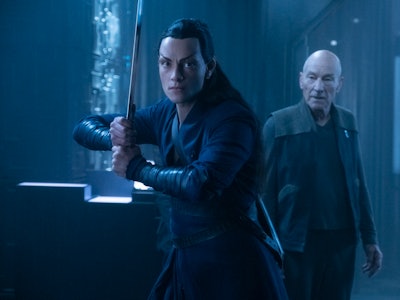
The deadliest verbal threat in Star Trek canon just became much clearer. Thanks to the third episode of Star Trek: Discovery’ s fourth season, one phrase that originated with Star Trek: Picard just got a deeper meaning. Like the swords of the Romulan warrior nuns — the Qowat Milat — the battle cry “choose to live” has more than one edge. Here’s how Star Trek continues to double-down on their version of the Bene Gesserit from Dune, the way Discovery just fleshed out the Qowat Milat, and why “choose to live” might not mean what we think. Spoilers ahead.
At the beginning of the new Discovery episode, “Choose to Live,” we see a Qowat Milat renegade named J'Vini (Ayesha Mansur Gonsalves) say the title words to a Starfleet officer before stabbing him. This pseudo-threat originates with the Picard Season 1 episode “Absolute Candor,” in which we learn that members of the Qowat Milat give their opponents a warning before killing them. It was badass in Picard, but in Discovery it hits different.

Tilly and Gabrielle Burnham discuss what “choose to live” really means.
In the new episode, Qowat Milat member Gabrielle Burnham (Sonja Sohn) tells Tilly (Mary Wiseman) that the concept is more complex than most people realize. Here’s what she says:
“When we say ‘choose to live,’ it's an abbreviated form of a longer thing... the path you are on has come to an end; choose to live . If you find yourself at the end of a Qowat Milat sword, it’s pretty easy to see that particular path is over for you. You either move on to a new path and live, or you stay and die.”
Tilly then asks if the ending of paths can be metaphorical. Gabrielle replies:
“In everyday life, the end of a path can be harder to recognize. You must be willing to look inside yourself with absolute candor.”
Within the episode, this longer description of the credos means that Gabrielle, Michael, and Tilly were able to bring J'Vini to justice without killing her. Before J’Vini surrendered, Gabrielle told her “this path is over.” But it didn’t mean that death was one choice and life was another. Choosing to live was less clear-cut than just getting stabbed or not.
This shift in the Qowat Milat honor code might not seem huge, but it reveals that even strict warrior nuns have some wiggle room. And this revelation may reveal something else.
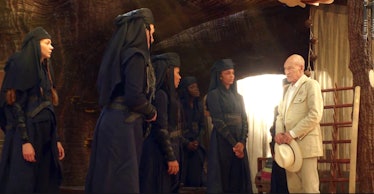
Picard with the Qowat Milat in Star Trek: Picard Season 1.
Although only introduced in 2020 within Star Trek: Picard , the Qowat Milat have now returned twice in Star Trek: Discovery . They played a prominent role in Season 3, and in Season 4’s “Choose to Live” their mythology continues to be fleshed out. Created by Michael Chabon and Kirsten Beyer for Picard , the Qowat Milat are quickly becoming the Bene Gesserit of Star Trek. In Dune , the Bene Gesserit are nuns with superpowers that include telepathy and precognition. They can also kick serious ass.
Because most Qowat Milat in the 32nd century are (probably) either Vulcans or Romulans, it’s a good bet that many also have some telepathic skills. But as we’ve seen now in Picard and Discovery , the Qowat Milat can also fight like hell. This latest Discovery episode makes it seems like we’ve not seen the last of the Qowat Milat, especially when you consider that protagonist Michael Burnham’s mom is a member.
But what about the broader Trek canon? Picard made it clear that Qowat Milat have been around for a long time, perhaps even centuries. Because of their prominence in two Trek shows, the Qowat Milat might become the biggest new aspect of Star Trek canon going forward. For example, in the timeframe of the upcoming spin-off Strange New Worlds , Starfleet shouldn’t know much about the Romulans yet. But that could only make it more surprising before its crew members from the classic Enterprise cross swords with these deadly space nuns and hear the chilling words “Choose to live.”
Star Trek: Discovery airs new episodes on Thursdays on Paramount+
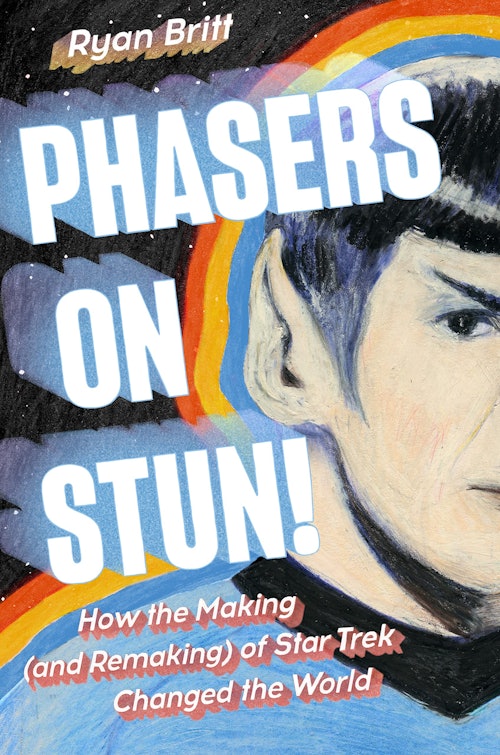
Ryan Britt's new book on the history of Star Trek's biggest changes. From the '60s show to the movies to 'TNG,' to 'Discovery,' 'Picard,' Strange New Worlds,' and beyond!
This article was originally published on Dec. 2, 2021
- Science Fiction
- More to Explore
- Series & Movies
Published Mar 2, 2022
The Natural Minimalism of Star Trek: Picard
Fashion blogger Tom Fitzgerald breaks down the universe's new look.
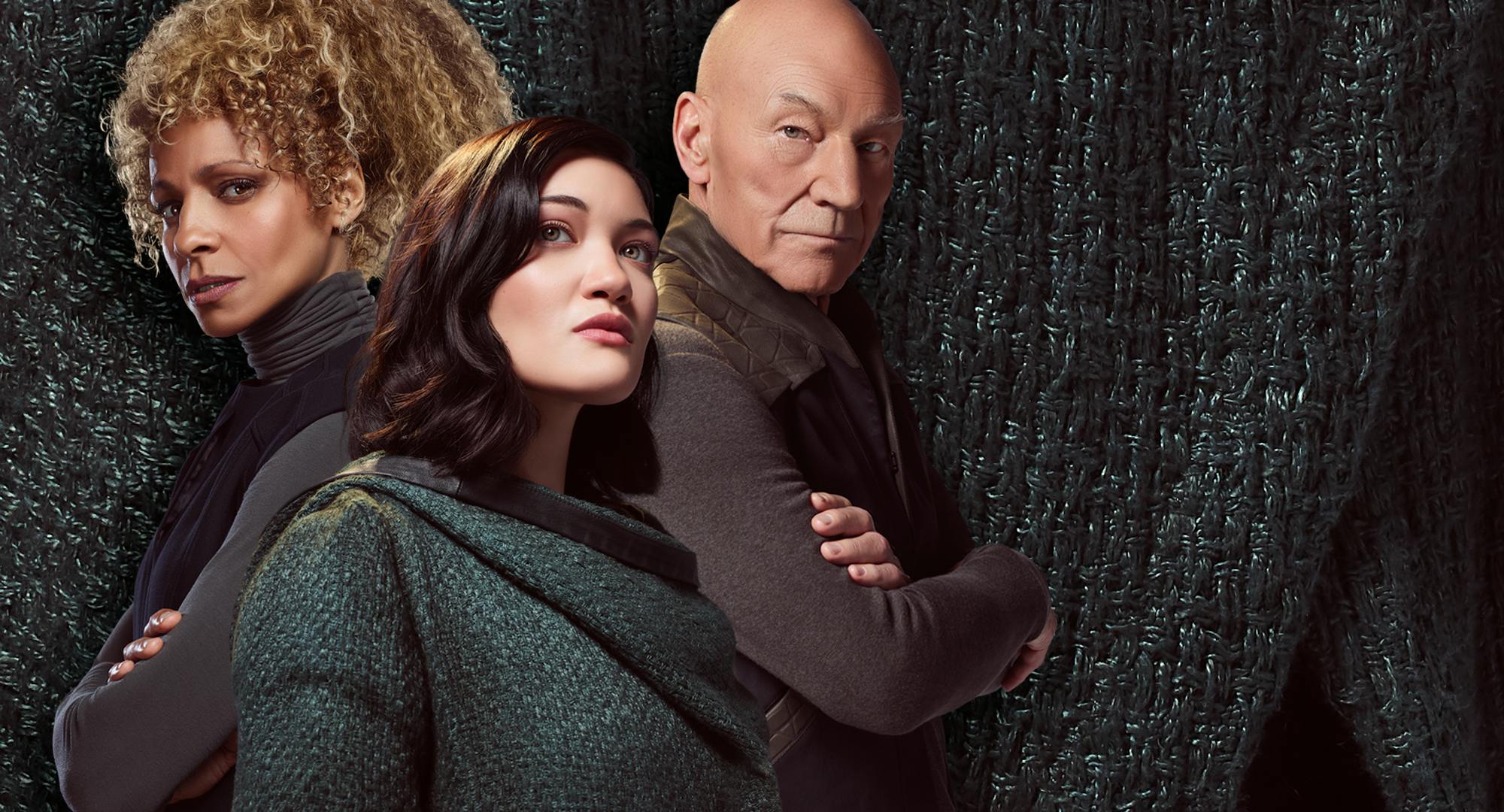
StarTrek.com
This article was originally published on April 1, 2020.
Star Trek: Picard has concluded its first season and with it, established the landscape of a post-Romulus galaxy, offering fans the most far-flung look yet at the shared universe of Star Trek , from politics to science to aesthetics. While it may not be the first thing most fans notice, I couldn’t help but be struck by what everyone was wearing. In less than 20 years’ time, the entire look of the late 24th Century changed drastically and I couldn’t help wondering just who was supplying everyone with all of those gorgeous sweaters.

From the bouffants and Beatle boots of The Original Series to the metallics and shoulder pads of Next Generation , to the military uniforms of Enterprise and even all the way to the lens flares and Apple-inspired aesthetic of the J.J. Abrams films, the look of Star Trek has always reflected the aesthetics of the time in which it was originally produced. As both a long-time fan and someone who’s written a good deal about the semiotics of costume design, I’ve always enjoyed the idea that, for instance, in the era of The Original Series , there was a minor vogue or trend for styles inspired by “mod” earth styles of the 1960s. This isn’t as crazy as it sounds; history is replete with examples of people cycling through short bursts of fascination with styles of the long past, like the classical Greek revival that inspired everything from architecture to women’s hairstyles and dresses in the Victorian era.
The shortest answer to the question of why everyone in 2399 is wearing totally 2020-appropriate casual separates and knitwear is that the clothes are pretty much the dominant style for audiences watching the show. The more interesting, interpretive, and much longer answer is that this jarring shift away from any sort of recognizable Treki an aesthetic for a good deal of the characters is saying something about those characters and the story they’re working their way through.
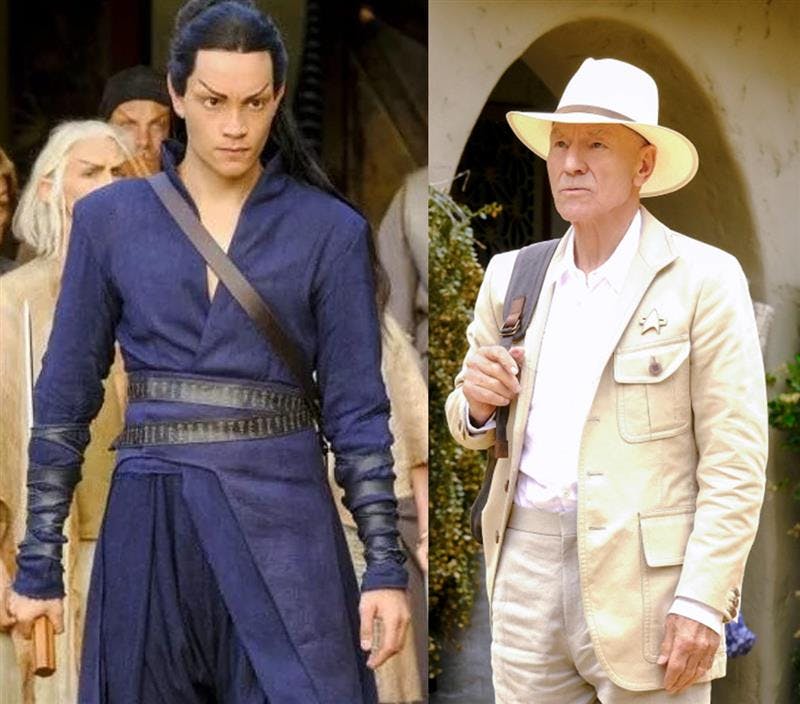
Costume designer Christine Bieselin Clark is clearly very deliberate in her choices. For instance, she smartly and even wittily used our own cultural references to inform how the characters are dressed at various times. The women of the Qowat Milat are clothed in robes and veils that evoke Catholic nuns or Muslim women in hijabs. Elnor is more or less coded to look like Romulan Legolas. Seven of Nine ditched her sparkly catsuit for the classic adventurer look of a leather bomber and boots, like some outer space Indiana Jones or Lara Croft. And in perhaps the most knowing wink of all, Picard visits the Romulan refugee colony on Vashti, complete with gifts of candy and European literature, dressed exactly like a 20th Century British colonialist on holiday: white linen suit, safari pockets and even a straw hat to complete the picture.
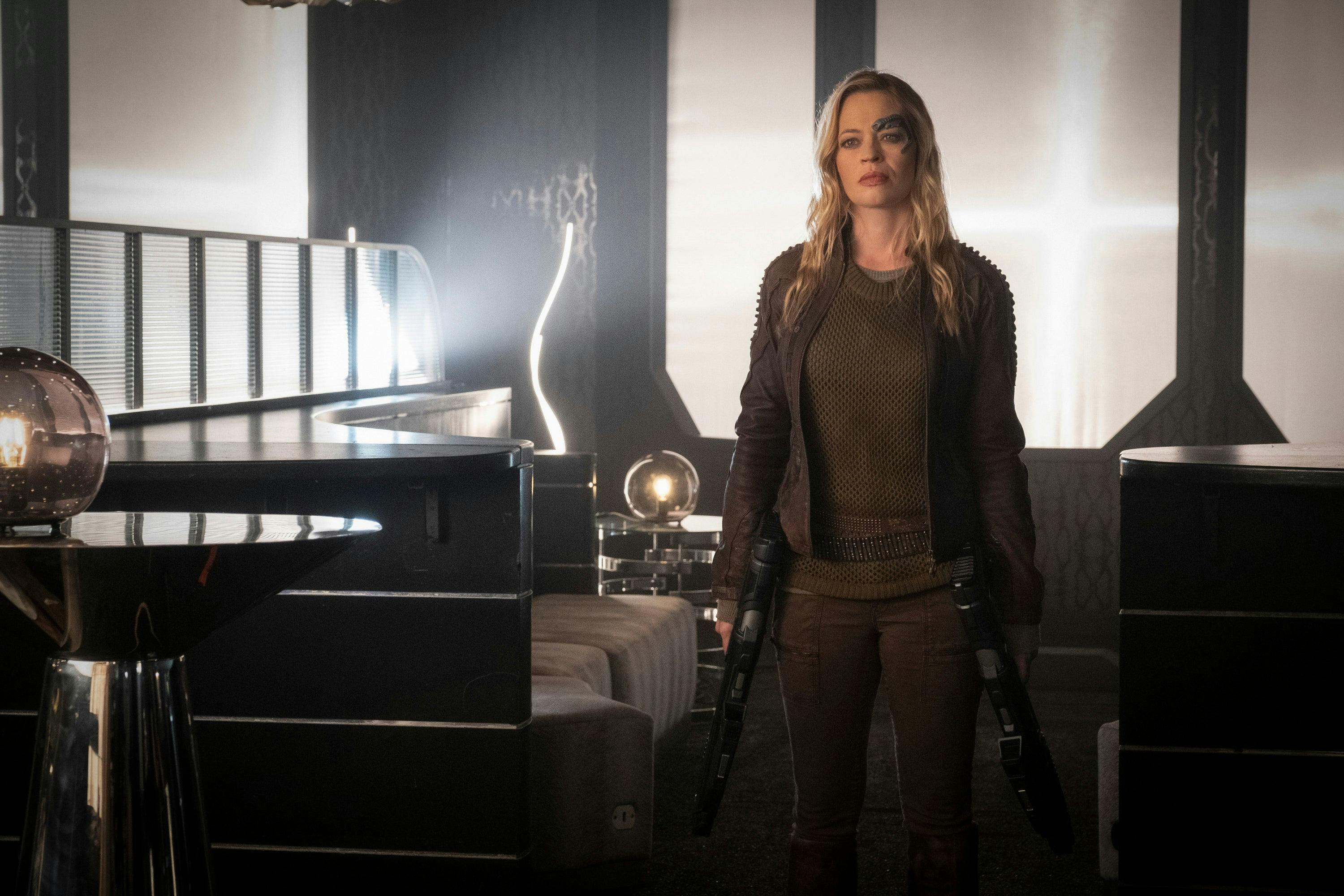
The world Picard inhabited as the series opens is a naturalistic one; a world bathed in sunlight, wreathed in vines, with rooms of wood, stone and leather. It’s a world where the former Starfleet admiral wanders his vineyards or the recesses of his mind while dressed in sporty sweaters and tweed caps in naturalistic browns and greens. His caretakers and assistants, Larisa and Zhaban, tend to his needs while modeling slouchy, comfortable knitwear and linens, rendered in soft natural tones of cream and brown. When Dahj first comes to see him, she’s dressed in a green tweed cloak, like some android Frodo, seeking help. Everywhere we look on Picard ’s Earth, characters embrace the natural.

This is a society gripped with fear at the prospect of synthetic life; a universe that has rejected synthetics, to the point that research on them had been outlawed. For a galactic society based on science and the exploration of new life forms, this is a tremendous step backwards. When societies regress politically or technologically, it’s not uncommon for them to regress aesthetically. Just as the bold new universe of the Kirk era mimicked the styles from the dawn of space exploration, the late 24th century, at a time of technological and philosophical stagnation, is looking to simple garments from natural sources that are untouched by technology. No shimmering or sparkle on these clothes, just muddy browns and greens in wool, cotton or leather. Natural fibers only.
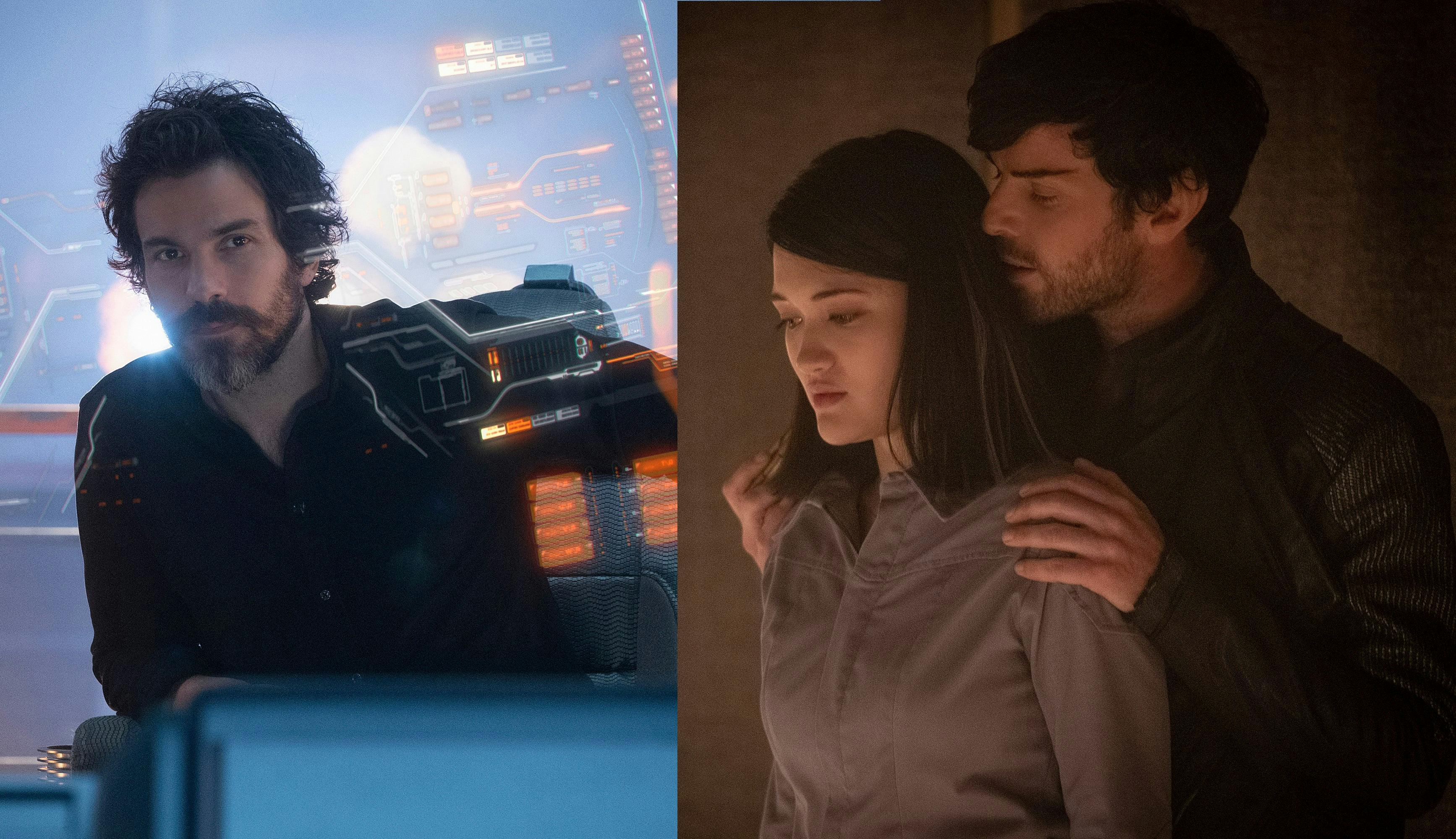
Contrast this with the way the show’s aesthetic shifts when Picard leaves earth. On La Sirena , there’s apparently one rule to the dress code: colors are not allowed. Almost instantly, Picard’s wardrobe shifts to nearly all-black, to match the black and gray ensembles of his crewmates. He even adopts a black leather jacket that mimics his former Starfleet uniform, with the color and insignia stripped out. There’s a distinction being made in the costume design between the naturalistic world, which is represented by planet-bound people like Picard, Dahj, Laris and Zhaban, and the people who live out in space, who are almost uniformly (no pun intended) rendered in utilitarian neutrals of black and gray, from Rios to Narek to Soji and practically everyone else on the Artifact. Picard’s doctor asked him if he really wanted to go out again into the cold. Agnes talked about how empty space feels. The universe of Star Trek: Picard , post Romulan diaspora, post-Borg, post-synthetic life, is not a universe of discovery, wonder and adventure, as in the past. It’s a cold, dark place and the people out in it dress accordingly.
Which is why it’s so notable and so jarring when the story shifts toward the Synths and their home planet of Coppelius, where everyone is dressed in brilliant golds and oranges; an explosion of color in stark contrast to the blacks and grays of outer space or the naturalistic hues of the earthbound.
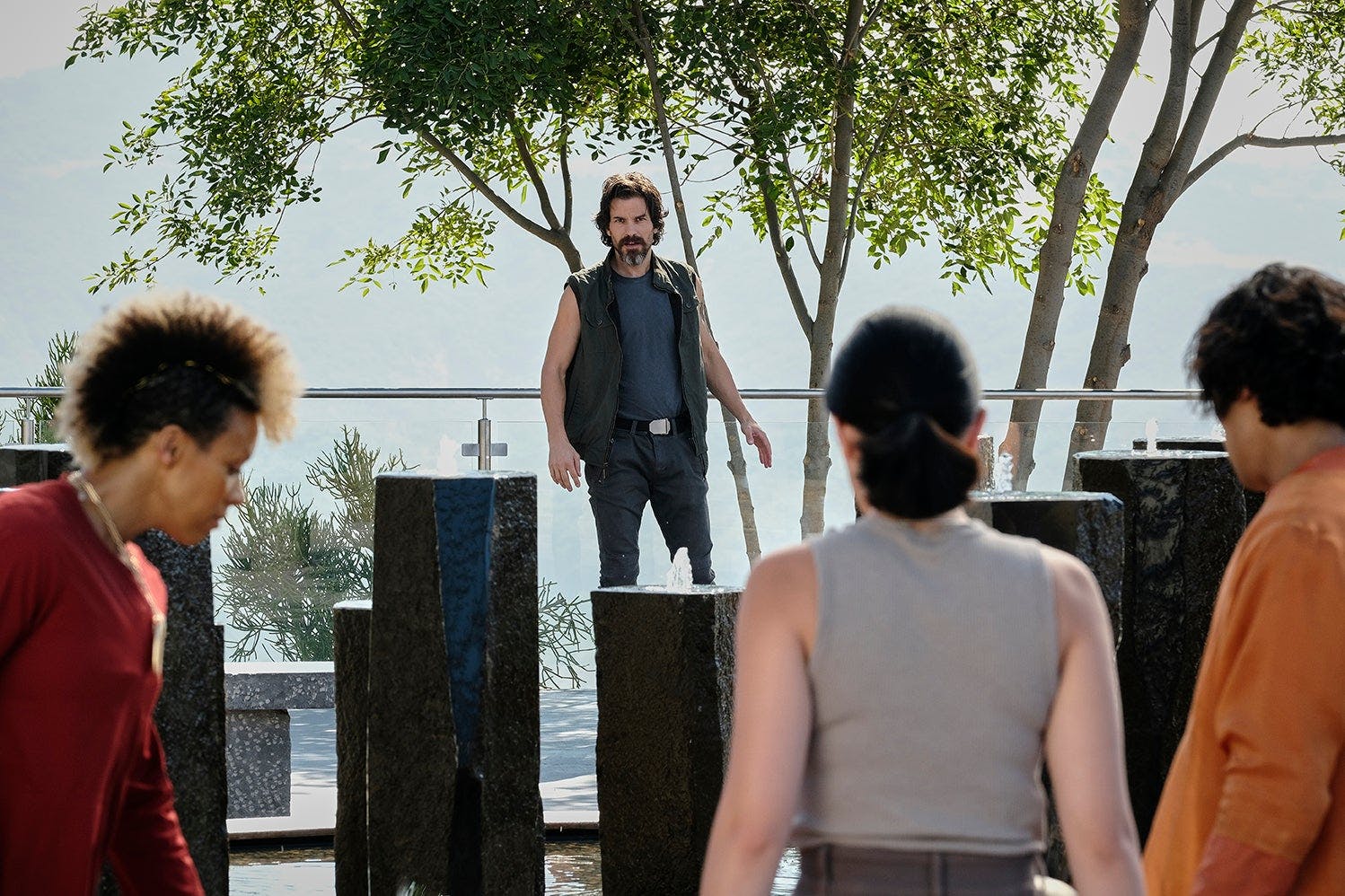
Unlike other Trek shows, Picard ’s universe doesn’t deal with federations or empires. It’s about people and beings living outside the system, who code their alliances and beliefs not in uniforms or insignia, but in the colors and textures of their clothing.
Tom Fitzgerald (he/him) is the co-publisher of the Tom & Lorenzo blog and the co-author of Legendary Children: The First Decade of RuPaul's Drag Race & the Last Century of Queer Life , available now.
Star Trek: Picard streams exclusively on Paramount+ in the U.S. and is distributed concurrently by ViacomCBS Global Distribution Group on Amazon Prime Video in more than 200 countries and territories. In Canada, it airs on Bell Media’s CTV Sci-Fi Channel and streams on Crave.
Get Updates By Email
Advertisement
Supported by
‘Star Trek: Picard’: Old Friends Sit on the Park Bench Like Bookends
Jean-Luc takes a detour to see some old friends, and comes across an unexpected one.
- Share full article

By Sopan Deb
Season 1, Episode 4: ‘Absolute Candor’
I didn’t expect another episode of setup this week, but Jeri Ryan’s first appearance as Seven Of Nine at the end made the payoff worth it. Still, this was the first episode of the season that felt a bit extemporaneous, after the tight storytelling of the first three installments.
Picard decides to take the expedition to find Bruce Maddox on a detour to the planet Vashti, a Romulan relocation site, where a group of what appears to be sword-wielding Romulan nuns called the Qowat Milat reside. An early flashback shows that Picard was a god of sorts here when he was leading the effort to rescue Romulans from the supernova.
A few words on the Qowat Milat: This is a group of secretive female warriors who believe in complete and total transparency in all things. And somehow they are still Romulan, in spite of rejecting all of the traditional Romulan values. On one hand, I applaud the writers for finding new and novel ways to explore and flesh out a traditional Trek villain. And yet: A new bunch of Romulan warriors who totally eschew Romulan traits seemed a bit off to me, given the amount of interactions “Trek” heroes have had with Romulans over the years. (I’m torn on this: Romulans are also traditionally secretive so perhaps it makes sense that this discovery is relatively recent.)
From the Department of Coincidences: The group Picard is fighting is the Tal Shiar sect, Zhat Vash, and the planet the Romulan warriors are on is Vashti. I’m wondering if this will come into play later.
This episode also reveals one of the closest things Picard has ever had to a child, Elnor. Elnor (Evan Evagora) is angry at Picard for abandoning him 14 years ago, when the synthetics attacked Mars. Since then, he has become quite a warrior himself and is perceptive in realizing that one of Picard’s flaws is that if something is not happening right in front him, he is generally uninterested, as Raffi can attest to. Even so, Elnor joins Picard on the quest, but not before beheading a former Romulan senator who threatens him. (Yikes! “Trek” is rarely this dark! And is anyone going to mention that Elnor seems oddly similar to Elrond from “Lord of the Rings”? Was this intentional? I must know.)
And of course, we have our first space battle in this episode, featuring Picard’s mode of transport, La Sirena. Side note: Was Jurati … very awkwardly flirting with Rios? For the love of all the Prophets, please give her something else to do. In the meantime, Rios — one of the best pilots in the galaxy, we are told — has some difficulty outmaneuvering an ancient Klingon Bird of Prey. That ship is purportedly being piloted by a pirate who has taken over the sector, although we never see said pirate. (This, of course, isn’t the first time a seemingly superior ship has trouble with an old Klingon ship. This is a “Trek” trope as old as time.)
Over on the Borg cube, Narek and Soji are still doing their thing. The scene where they both slide down a hallway as a “Borg ritual” was something else. Again, I’m not sure where this is going, but Narek awkwardly interrogating Soji, post romantic-slide, should be the first example in the “what not to do” chapter of the Spy Handbook.
What are we doing here guys? If you want to know why Soji wasn’t listed on a previous passenger manifest, at least put a ring on it first! Eventually, Rizzo shows up to seductively stroke her brother and then choke him. None of that is a typo, and I’m not entirely clear how she was able to do any of this, given that she is supposed to be a projection.
I’m having some fun with this episode because I’m a fun guy. But I did find the scenes on Vashti fairly compelling, because I appreciate exploring new terrain and Patrick Stewart fencing with a child makes for an enjoyable visual. This episode, directed by the upcoming cast member Jonathan Frakes, just felt a little distracting to me. However, seeing Seven at the end was joyous.
My assumption is that next week, we head to Freecloud with our favorite former Borg drone and we’ll learn what she has been up to.
Sopan Deb is a culture reporter, writing about the intersection of politics and culture, among other topics. He covered Donald J. Trump's presidential campaign for CBS News, and his work has appeared on NBC, Al Jazeera America and elsewhere. More about Sopan Deb
Explore More in TV and Movies
Not sure what to watch next we can help..
Maya Rudolph and Kristen Wiig have wound in and out of each other’s lives and careers for decades. Now they are both headlining an Apple TV+ comedy of wealth and status .
Nicholas Galitzine, known for playing princes and their modern equivalents, hopes his steamy new drama, “Mary & George,” will change how Hollywood sees him .
Ewan McGregor and Mary Elizabeth met while filming “Fargo” in 2017. Now married, they have reunited onscreen in “A Gentleman in Moscow.”
A reboot of “Gladiators,” the musclebound 1990s staple, has attracted millions of viewers in Britain. Is appointment television back ?
If you are overwhelmed by the endless options, don’t despair — we put together the best offerings on Netflix , Max , Disney+ , Amazon Prime and Hulu to make choosing your next binge a little easier.
Sign up for our Watching newsletter to get recommendations on the best films and TV shows to stream and watch, delivered to your inbox.
How Did ‘Star Trek: Discovery’ Become TV’s Most Boring Show?
A CRY FOR HELP
Ahead of the fifth—and final—season’s premiere, we look back at the many wrong turns of Season 4.

Geoffrey Bunting
Freelance Writer
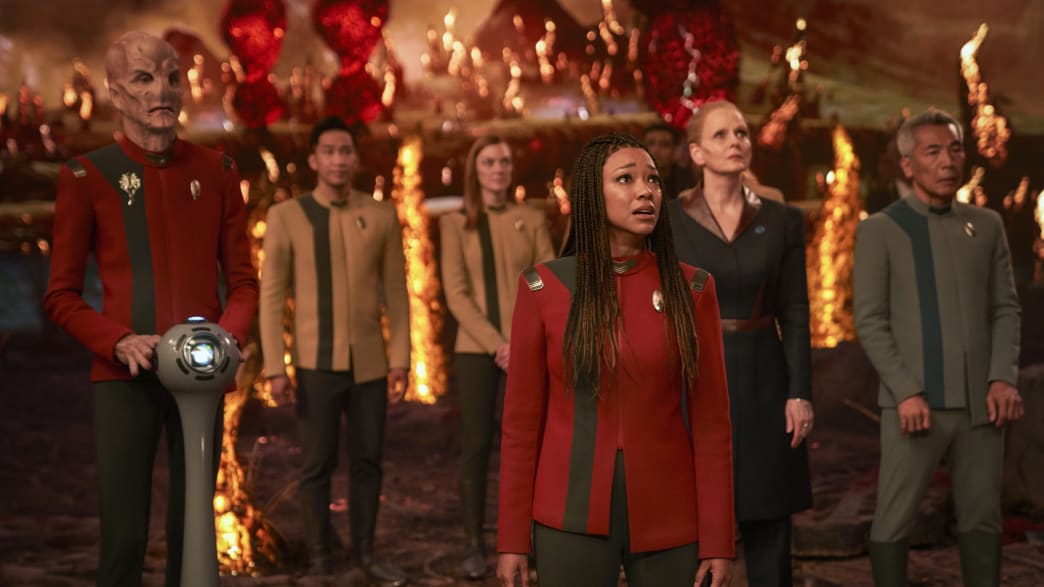
Marni Grossman/Paramount+
It’s been a hot minute since Star Trek: Discovery last graced our screens. When the fifth and final season starts April 4 on Paramount+, it will arrive two-and-a-half years after the debut of Season 4. That’s a long gap for such a forgettable season of Star Trek . As The Daily Beast Obsessed’s resident Star Trek tragic—they won’t let me leave; please send help—the unenviable duty of reminding everyone what happened on Discovery Season 4 in preparation for Season 5, unfortunately, falls to me.
It goes like this: It’s the 32nd century, and a gravitational anomaly is on its way to Earth—except it’s not an anomaly; it's an alien mining device. Burnham and the crew of the USS Discovery go and ask the aliens really nicely to stop mining and then everyone goes home and tries not to think about the billions of people it killed. That may seem a gross oversimplification of 13 hours of television, but it isn’t. Seriously—that’s it.
I need to eke out 800 more words out of this, however, so: Did you know lobsters can theoretically live forever, if nothing eats them and they don’t get stuck in their shells?
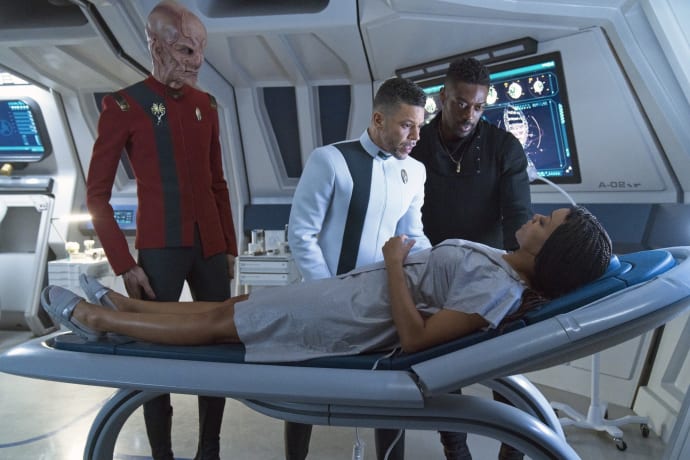
Doug Jones as Saru, Wilson Cruz as Culber, David Ajala as Book, and Sonequa Martin Green as Burnham.
Michael Gibson/Paramount+
Interesting stuff, right? Certainly more interesting than Season 4 of Discovery . If that brief rundown sounds like that should be, maybe, one episode of Star Trek instead of 13, you’re right. But this is Discovery ; it needs an overarching plot so this particular idea is spread over multiple slices of bread until all semblance of plot and pacing is functionally invisible.
If you really want to get into it, here goes: In Season 4, we join Michael Burnham (Sonequa Martin-Green) and her beau, Book (David Ajala), on what amounts to a Federation outreach program. They’re delivering the Federation’s newly-acquired dilithium, before Book heads home to Kweijan for an alien bar mitzvah. Shortly after, it’s destroyed before his eyes by a strange anomaly. This sets up the big theme of Discovery Season 4: therapy. Everyone gets therapy this season, even the ship’s computer (Annabelle Wallis), which is sentient now, gets therapy.
Book is left to come to terms with his grief, because the Federation has a new president, Laira Rillak (Chelah Horsdal), and Michael Burnham, one-time mutineer—and cause of over a hundred million Federation deaths—is not happy. As Ni’var, the reunified Vulcans and Romulans, plans to rejoin the Federation and help tackle the anomaly, now christened the DMA, Burnham is forced to tag along with the galactic politics.
This also introduces us to President T’Rina (Tara Rosling) who we quickly learn has Kelpian Fever, baby! This is the most interesting part of this season, because this Vulcan is down bad for Saru (Doug Jones) and will not admit it. We also get a multi-episode arc featuring Gray (Ian Alexander) getting a new android body, while Adira (Blu del Barrio) has to contend with how that changes their relationship—helped by more therapy—before both mostly disappear from the season.
New face Ruon Tarka (Shawn Doyle) has an idea of how to stop what he thinks is, in fact, an alien weapon: space-nuke it. It’s illegal but Tarka doesn’t care. He’s too cool for school, even when school says no nukes. This will be important later, but for now it’s time to debate whether it’s okay to space-nuke aliens.
It looks like things might get moving towards said aliens, but Burnham’s mother Gabrielle (Sonja Sohn) arrives because a rogue Qowat Milat (those pointless sword elves from Picard Season 1) has stolen some dilithium and it’s time to hunt them down. After some swordfights, it turns out the rogue space ninja stole the dilithium to save the Abronians—some random aliens who are there… for a bit.
Back on Discovery , everyone gets some time off and therapy from Doctor Culber (Wilson Cruz), who also gets therapy from another dude entirely because everyone telling him about their problems has him stressed. Book and Tarka, however, are done with therapy. They’re off to blow up the DMA, but we’ve still got five episodes to go, so that doesn’t work. Now, they’re off to find a new way to blow it up. Meanwhile, Discovery is jetting off to find the aliens who control the DMA, dubbed the 10-C, to negotiate. Both presidents come along— Rillak because it’s a political and diplomatic mission, and T’Rina to awkwardly eye-fuck Saru in Discovery ’s corridors.
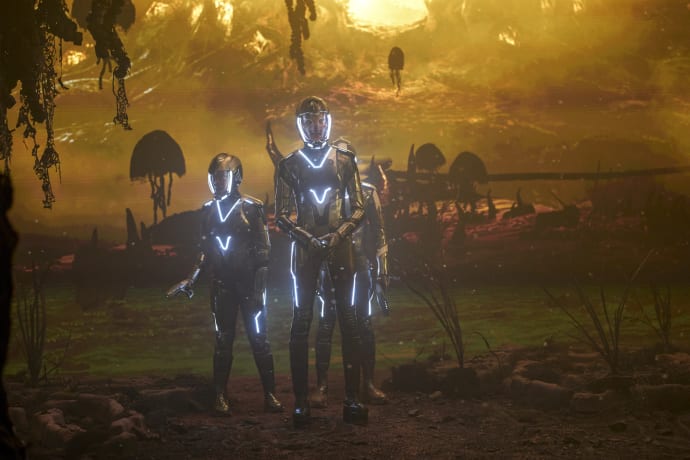
Sonequa Martin-Green as Burnham and Doug Jones as Saru.
Then, Discovery does some pushing the boundaries of space travel (which is mostly sparks and actors wobbling in their chairs), has a quick away team acid trip, and 11-and-some-odd hours in, we finally see who’s behind the DMA. They’re big space whale insect things. At this point, the series basically becomes Arrival , as the crew of Discovery use math to communicate with the giant super-aliens behind the force-field of their shuttle bay because they are proper nerds. At the same time, we learn that the DMA is on its way to Earth and Ni’var.
Admiral Vance (who we all love, because he’s Oded Fehr) begins evacuating, helped by Tilly (Mary Wiseman) who is now teaching at Starfleet Academy, while fending off space debris pushed at Earth by the DMA. Despite the apparent time pressure, Burnham and company spend some time patting each other on the back while Book and Tarka rock up. But Book has second thoughts when he learns it might not be so safe … to blow things up.
Vance finally breaks off evacuation efforts as things get too dangerous, staying behind with Tilly to protect Earth. At which point he produces two flasks of whiskey to celebrate their impending death. That the dude in charge of Starfleet is packing two flasks is never addressed.
The 10-C briefly gets angry at Book and Tarka’s intervention and it looks like Book dies in the resulting conflict. But no, the 10-C saved him. Only Tarka, who wasn’t receptive to therapy this season, bites it. The 10-C stop mining, Earth (and Vance and Tilly) are saved, Saru and horny space president hold hands, Book gets some community service, and everything ends up back where we started.
It’s sad that Discovery is ending, but it’s sadder how much Season 4 represented a downfall for a series that weathered sad nerds getting upset because Klingons got better make-up in order to revive the series for new audiences. For its first two seasons, it maintained a careful balance between the humanity of Star Trek and the more action-oriented pace of the most recent Star Trek movies. Even Season 3 , which saw Discovery move to the far future, was a smart and effective shift after Season 2 had explored old ground.
Yet, it feels apt that Season 5 will be the show’s last, given how much Season 4 felt like the backwash of Picard ’s love of references and name dropping, as opposed to the more interesting beginnings of Discovery , the suggestion that Elon Musk is a scientific luminary notwithstanding. If you’re one of the people that missed, or justifiably forgot, Season 4, however, now you know you’re not missing anything because it adds literally nothing to the series. Now, apropos of nothing, time to get some therapy—no idea what gave me the idea.
Got a tip? Send it to The Daily Beast here .
READ THIS LIST
Screen Rant
All 3 times star trek: discovery has mentioned jean-luc picard.
Captain Jean-Luc Picard's Starfleet legacy continues into the 32nd century, and his name has come up three times in Star Trek: Discovery.
Warning: SPOILERS for Star Trek: Discovery Season 5, Episode 1 - "Red Directive"
- Captain Jean-Luc Picard's legacy lives on in Star Trek: Discovery, as he's been mentioned 3 times in the 32nd century.
- Captain Michael Burnham may have a different command style, but her missions still echo Captain Picard's influence in the future.
- Star Trek: Discovery season 5 deepens connections to Picard & Star Trek: The Next Generation, highlighting the impact of Picard's achievements.
Captain Jean-Luc Picard (Patrick Stewart) has been referenced three times in Star Trek: Discovery , proving that his legacy extends all the way into the 32nd century. Introduced as the Captain of the USS Enterprise-D in Star Trek: The Next Generation , Jean-Luc Picard has become one of Star Trek's most beloved and enduring characters . Picard commanded the Enterprise for seven seasons of TNG and four movies, and returned years later in three seasons of Star Trek: Picard . With his diplomatic skills and collaborative command style, Picard remains one of Starfleet's most celebrated and accomplished officers.
As seen in Star Trek: Discovery seasons 3, 4, and 5, Captain Picard's accomplishments continue to be referenced in the 32nd century. Star Trek: Discovery's Captain Michael Burnham (Sonequa Martin-Green) may have a different command style from Picard, but her action-oriented approach works well for the fragile United Federation of Planets of the 32nd century. Even over 900 years in the future, Burnham's missions sometimes call back to those of Captain Picard. Although Burnham and the Discovery crew are from a time before Jean-Luc Picard was even born, his name has come up three separate times during their adventures in the 32nd century.
Star Trek: Discovery Season 5 Returning Cast & New Character Guide
3 “unification iii” - star trek: discovery season 3, episode 7, references picard's meeting with ambassador spock in tng's "unification".
The first mention of Jean-Luc Picard in Star Trek: Discovery comes in an episode that serves as a sequel to an iconic Star Trek: The Next Generation two-parter . In TNG's "Unification," Starfleet sends Captain Picard to look for Ambassador Spock (Leonard Nimoy), who was last seen on Romulus. Picard eventually finds Spock and learns that the Vulcan Ambassador has been working on a "personal mission of peace" to bring the Romulans and Vulcans back together. Spock has come to realize that his goal cannot be achieved through traditional diplomatic means, but he is pleased to find that many young Romulans are beginning to embrace Vulcan philosophies.
Among the 'personal files of Admiral Jean-Luc Picard,' Michael finds footage of Spock as he speaks about his goal.
In Star Trek: Discovery's "Unification III," Burnham seeks information about a project known as SB-19, which involved the Vulcans and Romulans working together to find a faster form of space travel. As Burnham prepares to make her request, she learns that her foster brother Spock was responsible for starting the process of Vulcan/Romulan reunification . Among the "personal files of Admiral Jean-Luc Picard," Michael finds footage of Spock as he speaks about his goal. Spock knew that his ultimate goal of reunification would not be achieved until long after his death, but even in the 32nd century, he is remembered as the one who made reunification possible.
The Qowat Milat, Romulan warrior nuns introduced in Star Trek: Picard season 1, were also revealed to have lasted into the 32nd century in Star Trek: Discovery season 3.
2 “Anomaly” - Star Trek: Discovery Season 4, Episode 2
References picard's synthetic golem body from star trek: picard season 1.
As the crew of the USS Discovery investigate the Dark Matter Anomaly, also called the DMA, Dr. Hugh Culber (Wilson Cruz) and Ensign Adira Tal (Blu del Barrio) work together to find a way to save Adira's partner, Gray (Ian Alexander). Despite Gray's supposed death, Adira was still able to see and speak with him, so Dr. Culber began researching ways to reunite Gray's consciousness with a new body. Culber came across the experiments of Dr. Altan Soong (Brent Spiner) , who had developed a method of transferring a consciousness into a synthetic golem body. Although the Soong Method had a very low success rate, Culber notes that it worked for Admiral Jean-Luc Picard.
Jean-Luc Picard's name drops in Star Trek: Discovery show a synergy with Star Trek: Picard.
In Star Trek: Picard season 1, episode 10, "Et in Arcadia Ego: Part 2." Jean-Luc finally succumbed to his terminal brain disease. Before Picard's consciousness fully dissipated, however, Dr. Altan Soong transferred it to the synthetic golem body he had constructed. Picard's new synthetic body was identical to his human one and would allow him to live the life he would have had if not for the abnormality in his brain. Gray receives his own golem body in Star Trek: Discovery season 4, episode 3, "Choose to Live." With help from Trill Guardian Xi (Andreas Apergis), Gray's consciousness was successfully transferred to the synthetic body, allowing him to continue with his life.
In Star Trek: Picard season 3, Admiral Picard's brain abnormality was revealed to be the result of dormant Borg DNA that had been left from his time as Loctus of Borg.
10 Star Trek: Discovery Positives You Only Notice On Rewatch
1 “red directive” - star trek: discovery season 5, episode 1, references picard's meeting with the progenitors in tng's "the chase".
In Star Trek: Discovery season 5's premiere , Captain Burnham and the USS Discovery get pulled into a galactic treasure hunt with connections to Captain Picard. The Federation's Dr. Kovich (David Cronenberg) sends Discovery on a top-priority mission classified as a "Red Directive," to find and retrieve an artifact from an 800-year-old Romulan science vessel. Discovery arrives too late to retrieve the artifact, a Romulan puzzle box, which had already been stolen by couriers Moll (Eve Harlow) and L'ak (Elias Toufexis). After Michael tries and fails to retrieve the puzzle box, she confronts Kovich for more information about the mission.
Star Trek: Discovery season 5 already has more connections to Star Trek: The Next Generation and Captain Jean-Luc Picard than any previous season.
Kovich reveals that the Romulan puzzle box contains information regarding the Progenitors, the ancient humanoid race that is believed to have created all humanoid life. In his briefing, Kovich says that Captain Picard "found a message left by a race of ancient beings," referencing the events of TNG season 6, episode 20, "The Chase." A Romulan scientist, Dr. Vellek (Michael Copeman), had been present on that day and had continued to research the Progenitors, eventually storing his diary within a Romulan puzzle box. After two episodes, Star Trek: Discovery season 5 already has more connections to Star Trek: The Next Generation and Captain Jean-Luc Picard than any previous season.
Star Trek: The Next Generation & Star Trek: Discovery are streaming on Paramount+.
Star Trek: Discovery
Star trek: the next generation.

IMAGES
VIDEO
COMMENTS
The Qowat Milat, formally the Order of the Qowat Milat, were a group of Romulan warrior nuns. They were an all-female group; while a male could train in their ways, he could never truly be one of them. The Qowat Milat were the most feared enemies of the Tal Shiar, and, by extension, the Zhat Vash. (PIC: "Absolute Candor"; DIS: "Choose to Live") The primary teaching of the Qowat Milat was the ...
Warning: SPOILERS for Star Trek: Picard season 1, episode 4.. Star Trek: Picard raised Trekkers' eyebrows by introducing the Qowat Milat, an order of Romulan warrior nuns who defy everything fans thought they knew about Starfleet's alien enemies. The Romulans are more prominent than ever in the CBS All-Access series charting the twilight years of Jean-Luc Picard (Patrick Stewart).
Subscribed to a life of absolute candor. Watch as cast and creatives discuss what went into creating Star Trek: Picard 's Elnor & the Qowat Milat. In addition to streaming on Paramount+, Star Trek: Picard also streams on Prime Video outside of the U.S. and Canada, and in Canada can be seen on Bell Media's CTV Sci-Fi Channel and streams on Crave.
The Qowat Milat's connection to the Star Trek universe is most prominently shown in the relationship between Captain Jean-Luc Picard and Elnor, a young Romulan warrior raised by the Qowat Milat ...
Perhaps Star Trek: Picard's most radical addition is the Qowat Milat, a sect of Romulan warrior nuns who practice "absolute candor". Elnor (Evan Evagora) is the rare male accepted into the Qowat Milat, and they became close with Picard when he relocated them to a new planet following the Romulan sun's supernova.
Full spoilers follow for Star Trek: Picard Episode 4, ... And two weeks later he was in L.A. for the first time ever, working on Picard. Elnor, the Qowat Milat, and an Absent Picard
Evagora was filming on location in Fiji for Fantasy Island when the Star Trek: Picard opportunity came his way, as the series producers searched across internationally for Elnor's casting. "They found me in, like, the final hour," he said. "I came back home to Melbourne for like two weeks in between filming, and I was given this script — big pages — but my character breakdown was ...
The Qowat Milat were confirmed to survive into the 32nd century during Star Trek: Discovery Season 3, now operating out of Ni'Var after the Burn which separated the planet and civilization from the Federation for centuries. The most surprising inductee into the far-future iteration of the sect is Gabrielle Burnham, Michael Burnham's long-lost mother who was presumed dead in the 23rd century ...
It's lovely (and pretty hilarious, given Dr. Jurati's delightful combination of awkwardness and forthrightness) to watch it happening in real time on Star Trek: Picard. It turns out that the Qowat Milat and Elnor have haunted Picard all these years (one of the many things, it seems), and so before he goes on his quest to find Bruce Maddox ...
He meets with Zani, the leader of a group known as the Qowat Milat - Romulan warrior nuns and, as we learn later, enemies of the Tal Shiar. They're looking after a boy, Elnor, whom Picard seems ...
Get to know Elnor, who was one of the Romulans relocated to planet Vashti and raised by a sect of all-female warrior nuns called the Qowat Milat. Stream all-new episodes of Star Trek: Picard on Thursdays, exclusively in the U.S. on CBS All Access.
D'deridex class warbird. One of the new elements of Romulan society that Chabon introduced in Picard was the order of Qowat Milat warrior nuns who believe in "absolute candor," which he ...
The latest episode of Star Trek: Discovery, "Unification III," hinges partly on the Qowat Milat, a sect of Romulan warrior nuns introduced in the first season of Star Trek: Picard.While acclimating to their new reality in the 32nd century - and while attempting to unlock the mystery of the Burn - Michael Burnham and Captain Saru learn that a massive shift has occurred on one of the Federation ...
The Qowat Milat way might sound potentially annoying, as our resident cyberneticist quips, but it's not — it's an enlightened episode of Star Trek: Picard that moves at breakneck speed in introducing new characters, new worlds, and new mythology about the ever-secretive Romulan civilization.. Bolstered by an intelligent and ambitious script from writer Michael Chabon, "Absolute Candor ...
Picard meets them through his efforts towards Romulan Reclamation. They are a group of, essentially, female Romulan warrior nuns - only their faith is not directed towards any one god, but instead to the principles of honesty - towards absolute candor. The nuns believe in absolute truth. In a distinctly un-Romulan fashion, the Qowat Milat ...
Amazon Brigade: The Qowat Milat is a very ancient order of Romulan warrior nuns who are so exceptionally skilled in combat that even the Tal Shiar fears them.; The Apprentice: Elnor learned hand-to-hand combat skills from the Qowat Milat nuns.Zani informs Picard that Elnor had completed his training last spring, but he cannot join their order because he's a man.
Vashti's Qowat Milat had taken in an orphaned boy named Elnor, and the young Romulan looked up to Picard as a surrogate father figure, enraptured by Picard reading him The Three Musketeers and teaching him how to fence. However, before Picard can continue his work on the planet, he is called away in response to the rogue synthetic attack on Mars -- with the Federation immediately cutting off ...
Although only introduced in 2020 within Star Trek: Picard, the Qowat Milat have now returned twice in Star Trek: Discovery.They played a prominent role in Season 3, and in Season 4's "Choose ...
The Qowat Milat debuted in Star Trek: Picard season 1 as the enduring enemies of the Romulan Tal Shiar and their extremist, android-hating offshoot, the Zhat Vash. Admiral Jean-Luc Picard (Patrick Stewart) befriended the Qowat Milat during the United Federation of Planets' efforts to save the Romulan people from their sun going supernova. After ...
The women of the Qowat Milat are clothed in robes and veils that evoke Catholic nuns or Muslim women in hijabs. Elnor is more or less coded to look like Romulan Legolas. ... Star Trek: Picard streams exclusively on Paramount+ in the U.S. and is distributed concurrently by ViacomCBS Global Distribution Group on Amazon Prime Video in more than ...
Patrick Stewart and Jeri Ryan in "Star Trek: Picard." ... A few words on the Qowat Milat: This is a group of secretive female warriors who believe in complete and total transparency in all ...
It looks like things might get moving towards said aliens, but Burnham's mother Gabrielle (Sonja Sohn) arrives because a rogue Qowat Milat (those pointless sword elves from Picard Season 1) has ...
The Qowat Milat, Romulan warrior nuns introduced in Star Trek: Picard season 1, were also revealed to have lasted into the 32nd century in Star Trek: ... In Star Trek: Picard season 1, episode 10, "Et in Arcadia Ego: Part 2." Jean-Luc finally succumbed to his terminal brain disease. Before Picard's consciousness fully dissipated, however, Dr ...